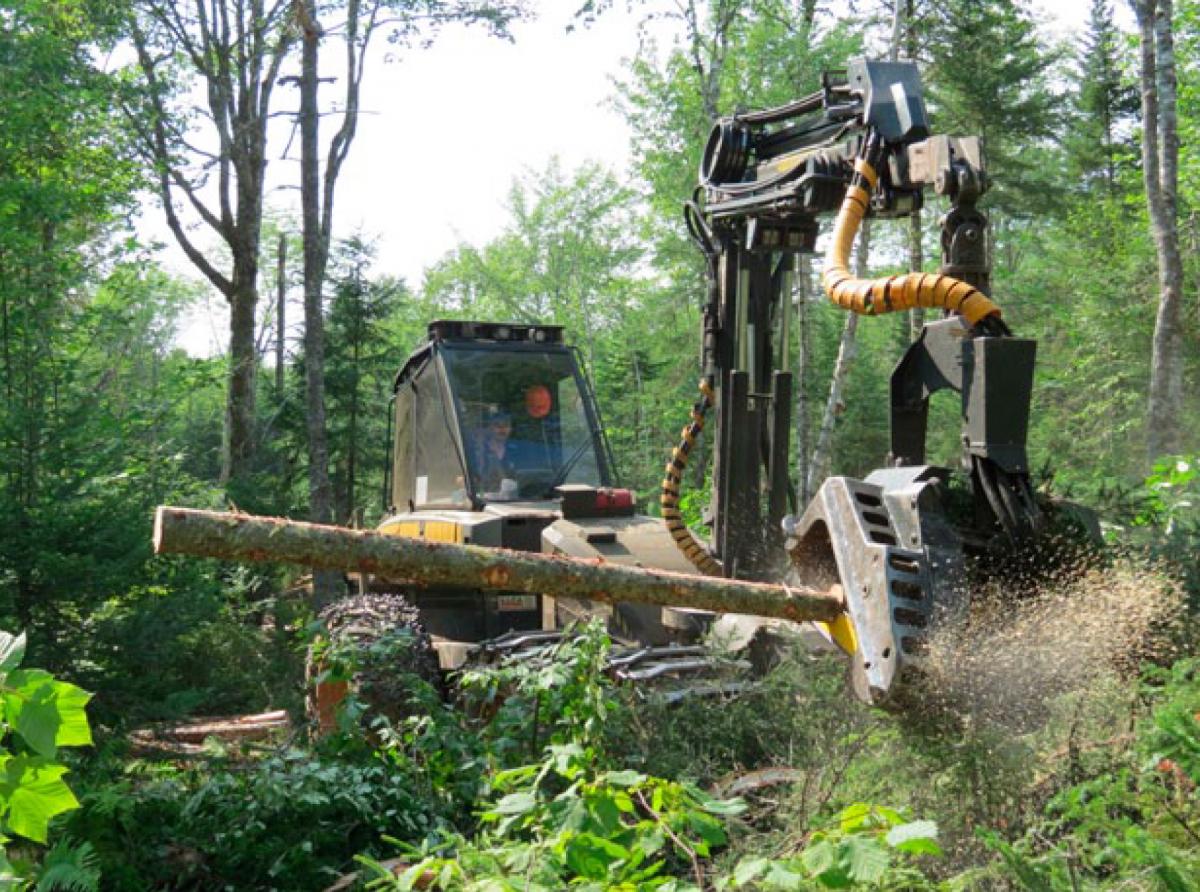Module 2: Harvesting on Your Woodland
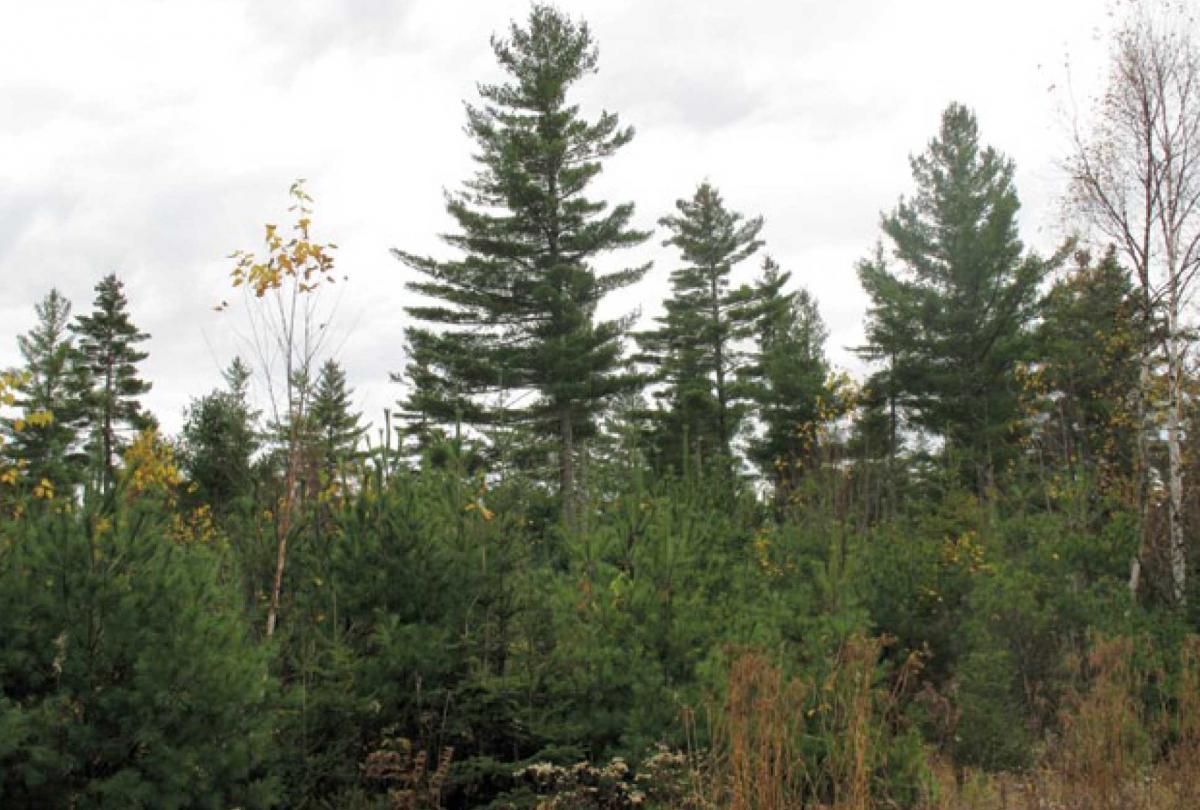
A healthy woodland is the result of good management
As a woodland owner you have an awesome responsibility. Your woodland is a living, breathing entity and you are responsible for keeping it vibrant and healthy. Sound like a daunting task? It is, but with a little assistance you can maintain and even improve the health of your woodland, while reaping some of the rewards at the same time!
The first module in this home study series has helped you understand the process of planning, which is a critical phase in the effective management of your property. In that module you learned how to use basic knowledge of tree species and ages, watercourses and wet areas, wildlife habitat and other features, to strengthen your woodland goals and objectives. In other modules you will learn about the complex web of life that exists on your woodland, the importance of good financial planning, and values that lay within non-timber products.
This module will introduce you to the concepts of timber harvesting, and the factors that should be considered when planning the harvesting of trees. You will look at the types of equipment used in tree felling and extraction, the various products that can be generated from a harvest, and – perhaps most importantly – the careful planning that should be undertaken in order to ensure a safe, efficient operation that causes as little damage to the environment as possible.
As stated above, it is essential that you have a plan for the management of your woodland.
For most woodland owners, hiring the services of a forest professional to prepare a plan is a good idea. Forest professionals are trained to understand the complexities of woodland management and are well versed in plan preparation.
Central to every woodland stewardship plan is a map of your woodland. It should show the shape of the property when viewed from the air, as well as stand boundaries, watercourses, wetlands, wildlife habitat and the location of access roads, fire ponds and other service entities.
 |
|
Aerial photo & planning tools: (clockwise from left) GPS, wedge prism, diameter tape, clinometer and compass. |
Because the map is a key element of your stewardship plan, it is important that it s accurate and up-to-date. Having access to a recent aerial photograph is a necessary starting point of any woodland map, and defining features of the woodland (such as tree species and terrain) can be obtained from the photo.
 |
| Good planning is important to successful woodland management |
When viewed through an instrument called a stereoscope, aerial photos appear three- dimensional. Viewing the photo, much can be learned about terrain features, such as whether the ground is flat or rolling, the relative steepness of hills, and whether ravines are present.
Time spent studying aerial photos is usually time well spent, and can save a lot of walking, particularly on large woodlands.
Lesson One - Values of Forests
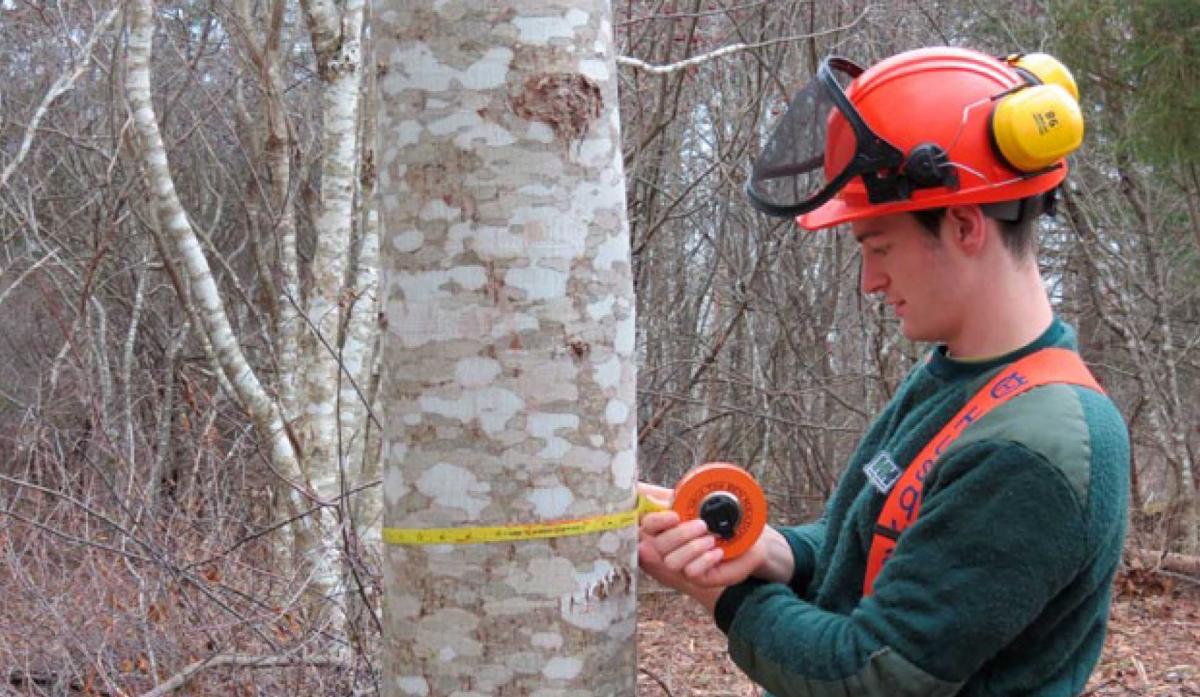
Knowing the species, size and maturity of your trees is essential to good harvest decision-making
Owning and managing woodland is a long-term endeavour. Like humans, trees can take decades to mature, and not all trees on your woodland may be growing at the same rate, nor are they all at the same stages of maturity. Some species, like red spruce, Nova Scotia’s provincial tree, does not mature until it is nearly half a century old. If you ever intend to harvest timber, it is important that you know the species and maturity of your trees. A tree is considered mature when it is old enough to produce healthy seed, and when its annual growth is beginning to decline. Some trees, like red spruce, eastern hemlock, sugar maple and yellow birch, may remain mature for more than a century before their growth begins to slow. Even when they are overmature, trees can still be valuable. They can provide important wildlife habitat for birds and mammals that require large-diameter trees for nests and dens. Often, hollow areas develop at the base of such trees, creating shelter for mammals such as red fox and even black bear.
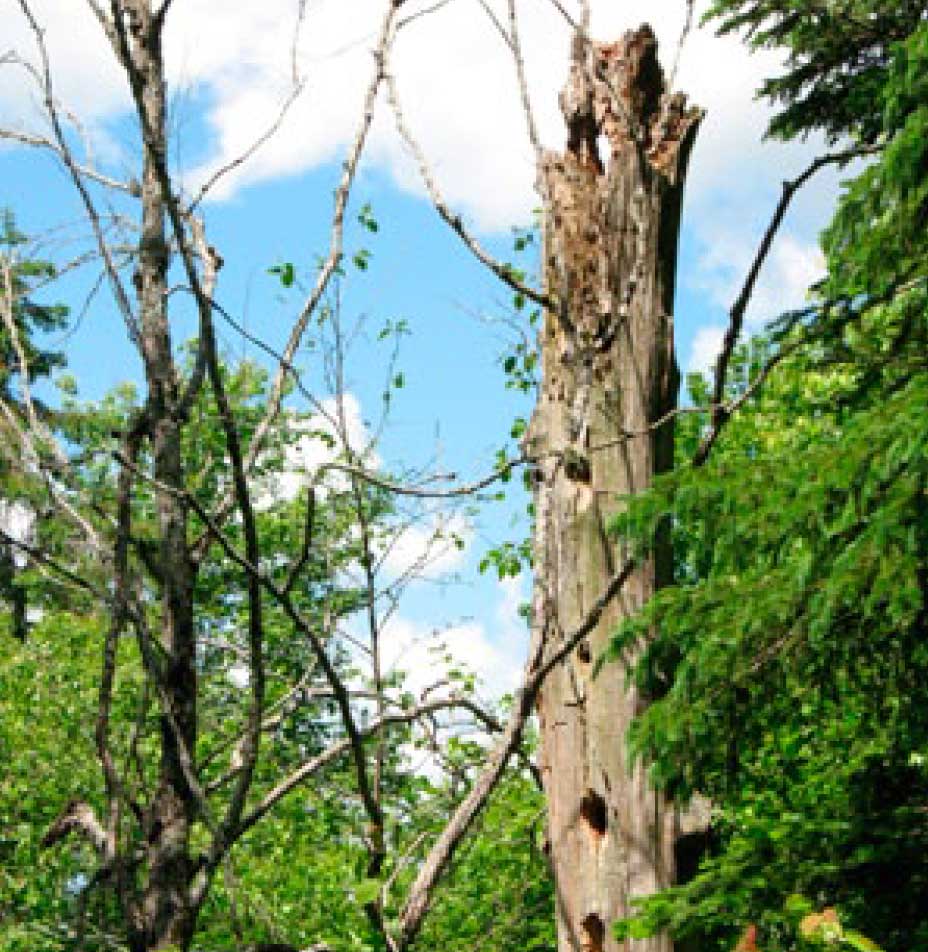 |
| A snag and cavity tree |
Cavities may also be present in areas of the tree high above the ground. These cavities are usually created by primary excavators – such as woodpeckers – that are searching for insects beneath the bark of the tree. These small cavities are important habitat for birds like black-capped chickadees.
As the wood begins to rot the cavity becomes larger and can host northern (and southern) flying squirrels, red squirrels, bats and even voles and mice that venture into a tree’s upper reaches. Overmature trees have values that are not easily quantified in financial terms.
Trees play an important role in the storage of carbon. As they grow, trees absorb carbon from the air and soil, accumulating it in their stems, branches and twigs. By storing carbon, trees help slow climate change.
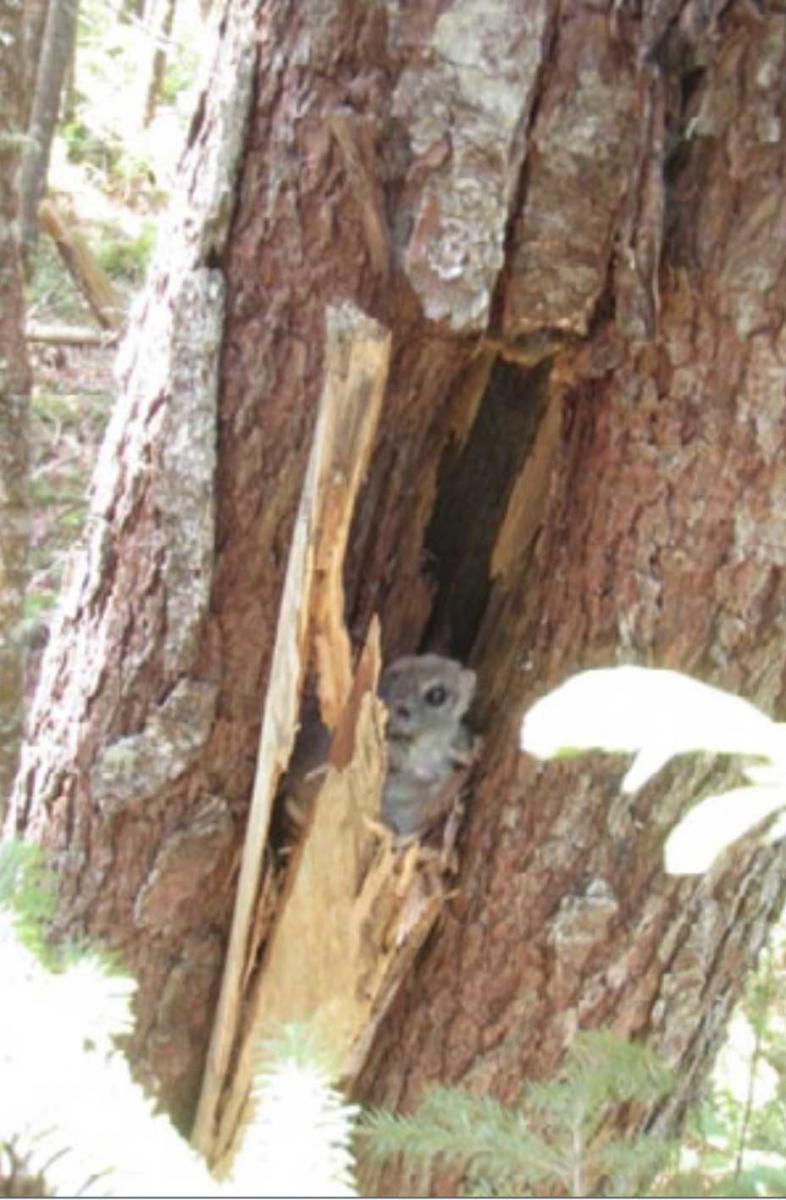 |
| A curious northern flying squirrel |
Forest Soils
The soils beneath a stand of mature and overmature trees are teeming with life. Trees are important in contributing biodiversity to forest soils. Tiny strands of fungi, called mycorrhizea, form dense networks in the soils beneath mature and overmature forests. Mycorrhizae link rootlets of trees with moisture and nutrients that would be otherwise inaccessible.
Many other types of fungi thrive in the forest soils and decaying wood of mature and overmature trees. These include the hyphae of mushrooms such as chanterelles and honey mushrooms, which are edible. A type of fungi called chaga grows on the trunks of birch trees, and can be used for making a tasty tea.
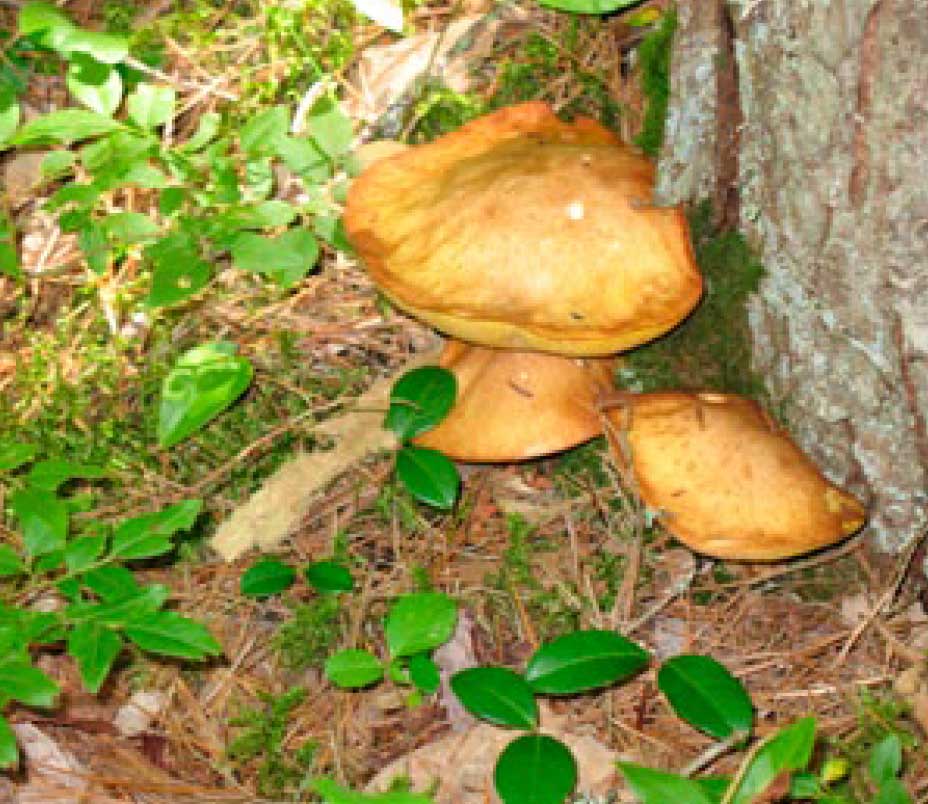 |
| Mushrooms are evidence of complex life beneath the forest soil. |
Soils rich with fungal strands are important to wildlife species that require such concentrated masses of mycorrhizae for food. Examples include flying squirrels, red-backed voles and blue-spotted salamanders that rely on a nutritious moist environment for food.
Mycorrhiza is an important driver in the cycling of forest soils.
Why Harvest?
Harvesting your woodland is an important decision which should be based on the condition of your forest stands.
Timber harvesting can be undertaken for a variety of reasons, including:
- Selling your trees for a profit
- Creating conditions suitable for the next crop (regeneration)
- To promote the growth of crop trees
- Ensuring a renewable source of forest products over the long term
- Enhancing the visual appearance of a stand
- Developing stand characteristics suitable for wildlife
- Promoting other values of your woodland, such as recreation
- Salvaging the financial value of a stand damaged by insects, disease or wind
- Harvesting trees for your own use
Not all trees that are cut need to be large diameter. Markets exist for small-dimension timber that can provide a good return.
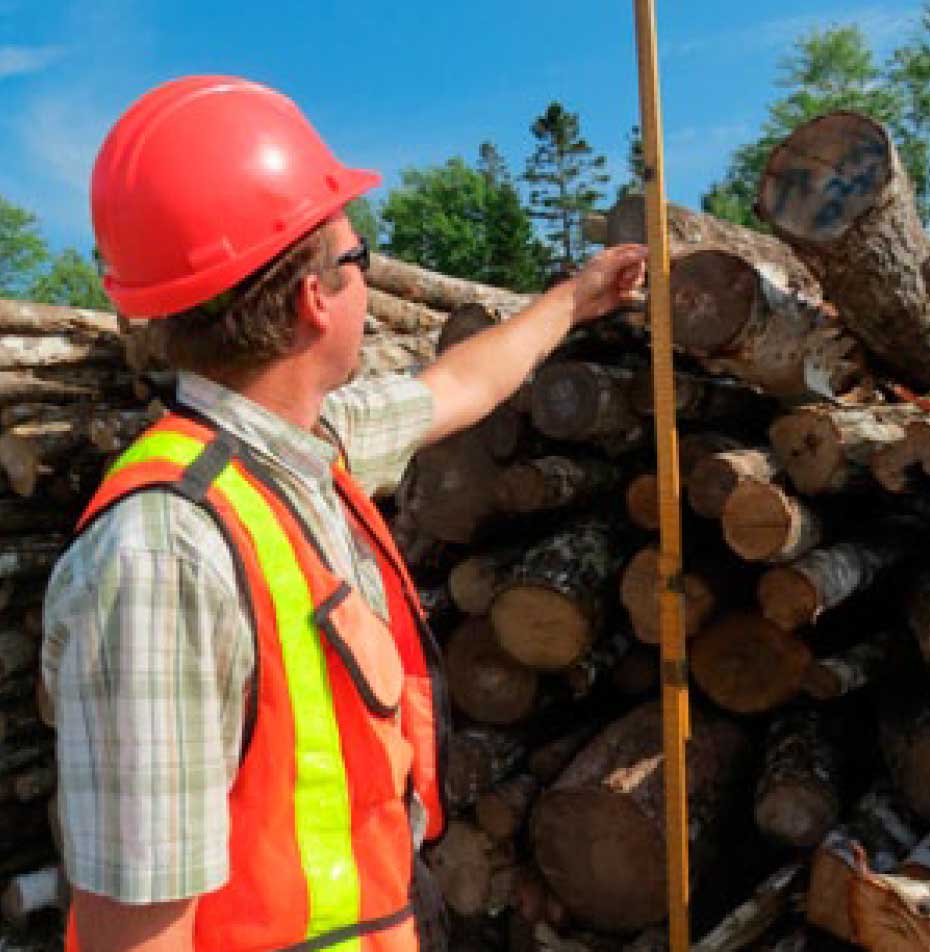 |
|
Scaling firewood for sale |
A harvesting operation must, at a minimum, include the following:
- Harvesting of a sufficient volume of wood to meet your objectives, which may include making a profit
- Protection of trees that may be left standing for future harvesting, or as wildlife habitat
- Avoiding damage to the soil through compaction and rutting, which can lead to erosion and decreased site productivity
- Protection of watercourses and wetlands which provide significant ecological values
- Operating safely and efficiently
- Leaving the harvested site in a condition that does not diminish its future use for both timber and non-timber values
- Consideration of regeneration
The terms “logging” and “harvesting” are often used interchangeably. Both refer to the process of felling, processing and extracting the timber to a site where it is accessible to trucking.
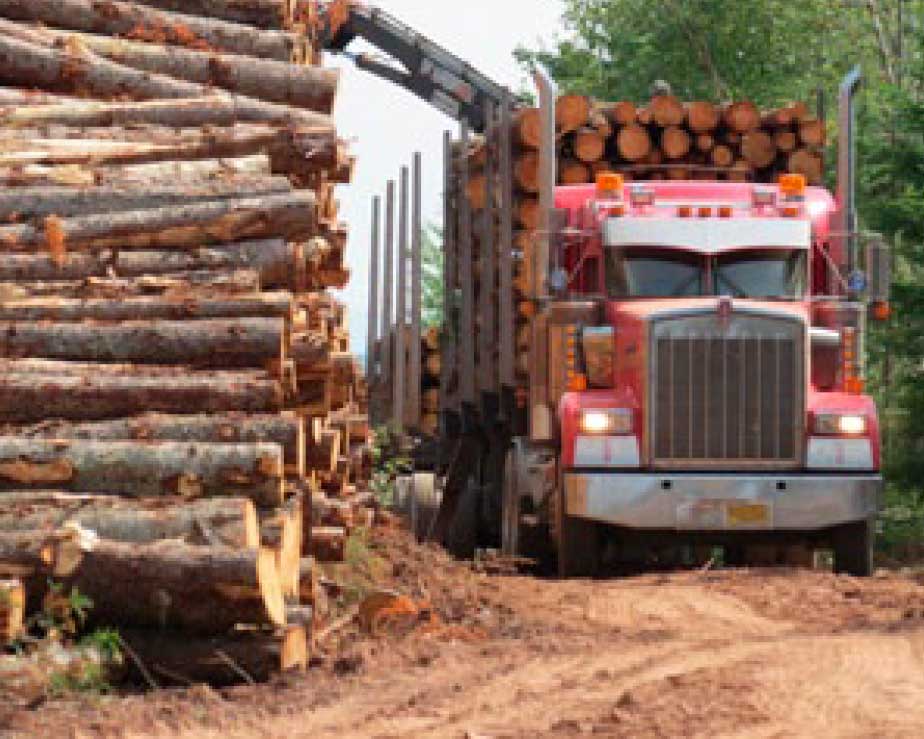
Trucking is an essential of every harvesting operation
For successful timber harvesting to occur, a number of factors must be considered. Think of moving several hundred (or thousand) tonnes of heavy, bulky trees over rough ground, then transporting them to a mill perhaps hundreds of kilometers away. You must do this while protecting the integrity of the forest ecosystem, including the soil, watercourses, standing trees and existing seedlings and other plants. This task obviously cannot be taken lightly!
 |
| Disease or insect outbreaks may hasten harvesting decisions, such as in this stand of white spruce killed by bark beetle |
Once a stand is overmature or infested with insects or infected with disease, there may be few alternatives to harvesting, other than letting the dynamics of the stand run its natural course.
Wildlife Considerations during Harvesting
When large, overmature trees die, they become valuable habitat for many species of wildlife. As discussed in Module 4, the trees that offer the most benefit to wildlife are large-diameter, shade-tolerant hardwoods such as sugar maple, yellow birch and red oak. Due to damage caused by wind, lightning strikes and resulting rot, these trees can have large hollows that make ideal nests and dens for a variety of species. These trees may live for centuries, providing steady shelter for large and medium-size mammals and birds.
 |
|
Some trees create good wildlife habitat |
Large trees also provide good platforms for stick nests. Hawks, owls and eagles usually require large trees in which they can build their nests. You may find a barred owl nest in a yellow birch tree that has a wide, spreading crown. If you have white pine trees that are standing head-and-shoulders above all the other trees on your woodland (these are called supercanopy trees), bald eagles may have built a stick nest in one or more of them.
Knowing your woodland and the kinds of wildlife habitat that use it can help you make good decisions when you wish to harvest timber. Spending some time walking your woodland looking for signs of wildlife is time well spent. Don’t forget to look up: stick nests are easy to overlook. Pay attention to trees that have died and are still standing (snags), since cavities can hold the nests of saw-whet owls, American kestrels and other small predatory birds.
A forest raptor that requires undisturbed areas of large trees for nesting is the northern goshawk. Although uncommon, goshawks have territories that can include both dense cover and open woodland.
 |
| Northern goshawk. Photo courtesy of NSDNR |
Planning Your Harvest
We’ve all heard the saying, “Measure twice, cut once.” And once a tree is cut, there is no way of putting it back! For that reason, it’s important to have a clear and thorough plan in place.
Some of the questions that need to be answered when planning your harvest include:
- What wood markets are available and what are the prices?
- What wood products can I produce?
- Is the timing right, including suitable ground conditions?
- Can I access the stands to be harvested?
- What equipment is best suited to the job?
- Will my revenue cover my expenses, and will I make a reasonable profit?
- Should I do the work myself or hire a contractor?
- How will the harvest impact the other values that I have for my woodland?
- Will the harvest impact neighbouring woodland?
 |
| Plan your work, work your plan |
Timing Your Harvest
Many birds such as hawks and owls begin breeding and building their nests in early spring, so it is important to avoid disturbing them at this time of year. Once eggs are laid, birds are very prone to even small disturbances and will leave their nests if the disturbance is prolonged.
If you are planning a harvest during a given year, both the stand that is considered for harvest and the area around it should be thoroughly inspected for stick nests and large cavity trees. If it appears that they are in use by hawks, owls or eagles, buffer zones should be established with flagging tape and every effort should be made to avoid disturbing the birds. Any sizable stick nest should be reported to your Regional NSDNR Wildlife Biologist.
During the active nesting months of May and June, it may be prudent to avoid working in the area altogether, since the noise of chainsaws or heavy equipment can persuade raptors to leave their nests and young.
It is good to keep tabs on what is happening on your woodland at all times of the year – even in winter. Areas of thick conifer (softwood) cover are frequently used by whitetail deer during winters of heavy snow. These sites are called deer wintering areas and can be several hectares in size. Within these stands the snow is less deep and the air temperature a little warmer than surrounding areas, making a difference in survival for deer that tend to congregate here. If a deer wintering area is slated for harvesting, ensure that there is an alternate area nearby in which deer can take refuge during winters of heavy snow.
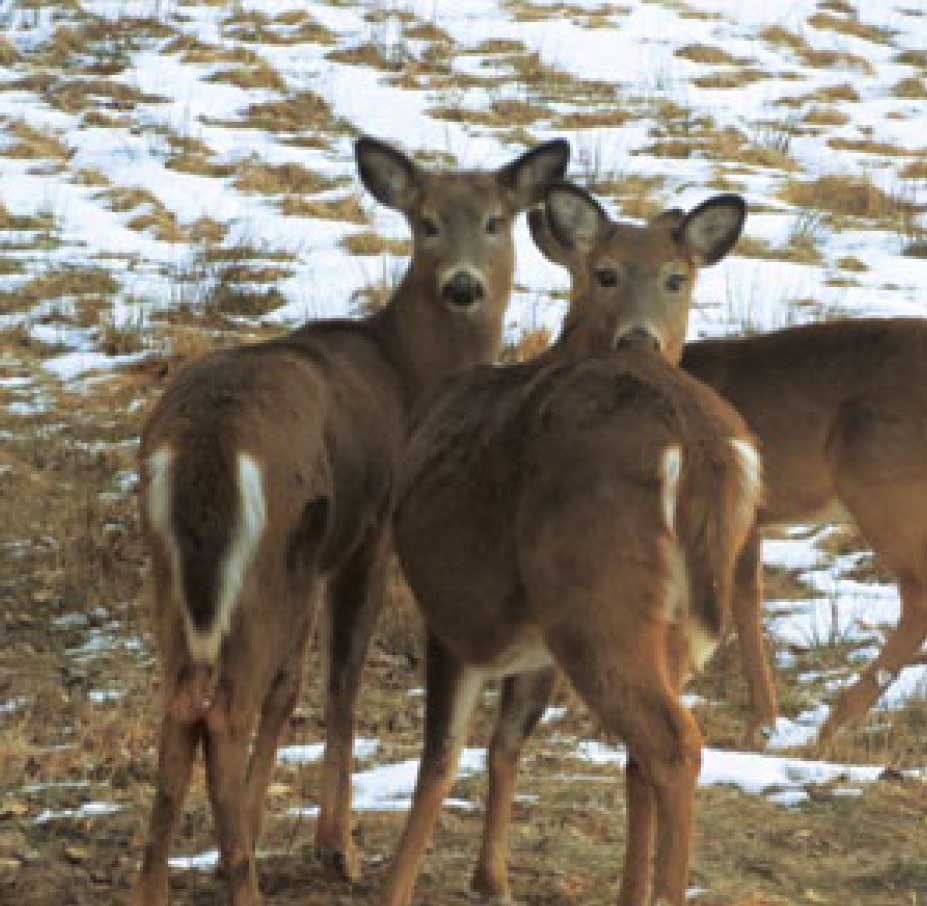 |
| During winter, whitetail deer forage for food in open fields, but prefer to shelter in thick cover. |
Considering the seasonal conditions of your forest soils can help you avoid problems with soil compaction and rutting caused by heavy equipment. During wet seasons, forest soils can be significantly damaged by equipment as light as a farm tractor. Wetter sites may be better left for drier times of the year, or during periods when soils are frozen.
Ponder Regeneration Prior to Harvesting
Before cutting even a single tree, progressive woodland owners consider what will replace it, and how that will occur. It’s important to plan for healthy regeneration in areas that are about to be harvested.
You may wish to ask yourself the following:
- Is a good seed source available that will provide an abundance of robust, healthy seeds?
- Are the available seeds from species that are suited to the site, and to my future plans?
- Will the seed be available during a good seed crop year?
- Will I need to partially, or fully, plant the site to achieve an adequate, even distribution of new trees over the entire site?
- If the site will require planting, where will I obtain the seedlings and who will plant them? And how much will it cost? Will the site need preparation for planting?
- How will I control competing vegetation?
- Is there silviculture assistance available for the type of harvesting that I wish to do?
- Take note of advanced regeneration. Is it good quality? How tall is it? Will it be damaged by the harvesting operation?
- What vegetation and soil types are present? Can I identify the forest ecosite type?
These are just a few of the many questions that should be answered before a site is harvested.
Module 2 - Lesson One Quiz
| Questions: | 10 |
| Attempts allowed: | Unlimited |
| Available: | Always |
| Pass rate: | 75 % |
| Backwards navigation: | Allowed |
Lesson Two - Best Management Practices in Forestry
A Best Management Practices Manual has been developed for Nova Scotia. The manual discusses the important aspects of woodland management and provides a guide for those interested in carrying out forestry operations.
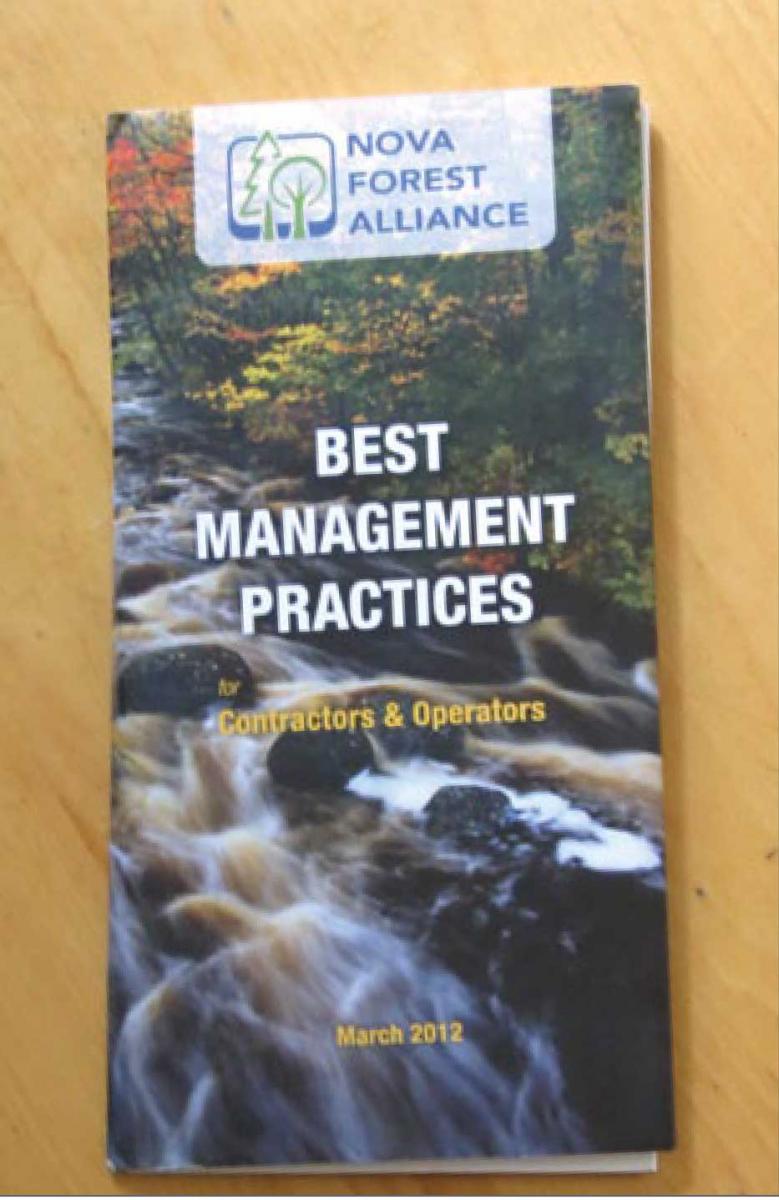 |
| Best Management Practices manual |
Wildlife Habitat and Watercourse Protection regulations
Of particular interest to those contemplating harvesting activities, are Nova Scotia’s Wildlife Habitat and Watercourse Protection Regulations. You should become familiar with these regulations, since they may significantly impact the ways in which you manage your woodland.
The Wildlife Habitat and Watercourse Protection regulations can be summarized as follows:
- Buffer strips must be left along watercourses
- Because the area next to a watercourse provides food and shelter for many species of wildlife, Special Management Zones at least 20 m in width must be left along any watercourse that is 50 cm or more in width. Some harvesting is permitted within this zone under certain conditions.
- Legacy/wildlife clumps must be left in any harvested area greater than 3 hectares
- At least 10 living trees must be left standing for each hectare harvested. These trees should be left in clumps, with a minimum of 30 trees per clump, and the clumps should be representative of the area that was harvested.
- Coarse woody debris should be left in the harvested area
- Wildlife often utilize standing dead trees, fallen trees and rotting logs for habitat. Decaying wood is an important source of nutrients for the next forest.
 |
| Aerial view of legacy/wildlife clumps. Photo courtesy of NSDNR |
Nova Scotia’s Code of Forest Practice
Ecosystem-based forest management is at the center of Nova Scotia’s Code of Forest Practice. Published in 2010, this document promotes sustainable forest management on all forest lands in the province. Forest ecosystem classification and pre-treatment assessments serve as the basis for stand-level planning within the context of forest landscapes.
The Code of Forest Practice addresses forest harvesting, and indicates that provincial harvest levels will be sustainable. Natural regeneration will be encouraged, and that where it is insufficient or of inferior quality, planting or seeding will be undertaken.
The Value of Forest Ecosystem Classification in Making Harvesting Decisions
When it comes to harvesting, forest ecosystem classification can be used to determine whether a particular stand is suited to partial harvesting or to clearcutting, or whether the stand should be harvested at all.
In all situations, an accurate appraisal of the forest site through forest ecosystem classification (FEC) will determine whether heavy equipment should be operated on the soil. By assessing ground vegetation and soil types, soil compaction and rutting hazards can be determined, as well as windthrow hazard of the remaining trees in a partial harvest.
Forest vegetation can be used to help classify forest ecosystems, since different plant species have specific requirements for moisture, sunlight and nutrients. Certain plants grow only on poorly drained sites, in which the water table is usually close to the surface. During a warm dry summer, it may be difficult to determine if a forest site is poorly drained since there is little or no moisture visible. Plants can give us clues. Some plants, like cinnamon fern and sphagnum moss, are called indicator plants because they indicate a normally wet site and cannot survive on well-drained sites.
 |
| The presence of cinnamon fern could indicate a west forest site. |
When soils contain more than 20 percent clay and less than 50 percent sand, they may be prone to compaction and rutting. While rutting causes obvious above-ground disturbance, the impact to the sub-surface soil structure can be permanent and profound. Tree roots and soil organisms can be damaged. Lateral movement of water can be impeded as compaction crushes vital tiny air spaces in the soil. These spaces, called pores, also provide valuable oxygen to organisms that promote the cycling of nutrients and aeration within the soil. Assessing forest soils, then, is of paramount importance in operations in which heavy equipment is to be used.
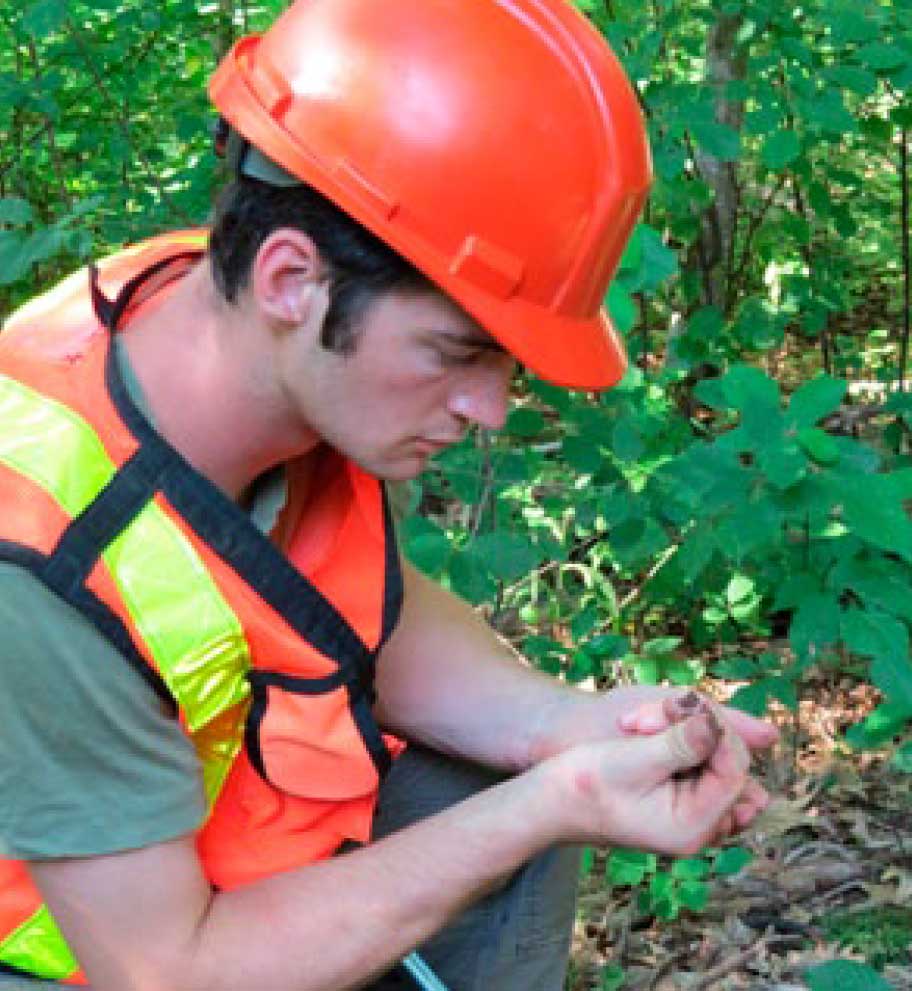 |
| Sampling soil texture is an important step in identifying soil type. |
The procedure used in this determination is called pre-treatment assessment and is a formal method of collecting data on a stand. Pre-treatment assessment is an accurate way of gauging the quality of trees in a stand and whether crop trees that are left after a partial harvest will be vulnerable to windthrow. Pre-treatment assessment also assesses the soil on a site to determine whether the soil will be susceptible to compaction and rutting if heavy equipment is used during wood extraction.
Forest professionals that are FEC-certified can help you with this important step in the decision- making process. If a stand is found to have good quality trees which will not decrease in quality or value over the next 15 years, and if the soil is well drained and deep enough to allow strong tree rooting, a partial harvest may be recommended. If, on the other hand, most trees are of poor quality and will not improve over 15 years, and the soil retains too much moisture or is shallow, partial harvesting may not be the best option.
See Appendix A for further information on how pre- treatment assessments are conducted.
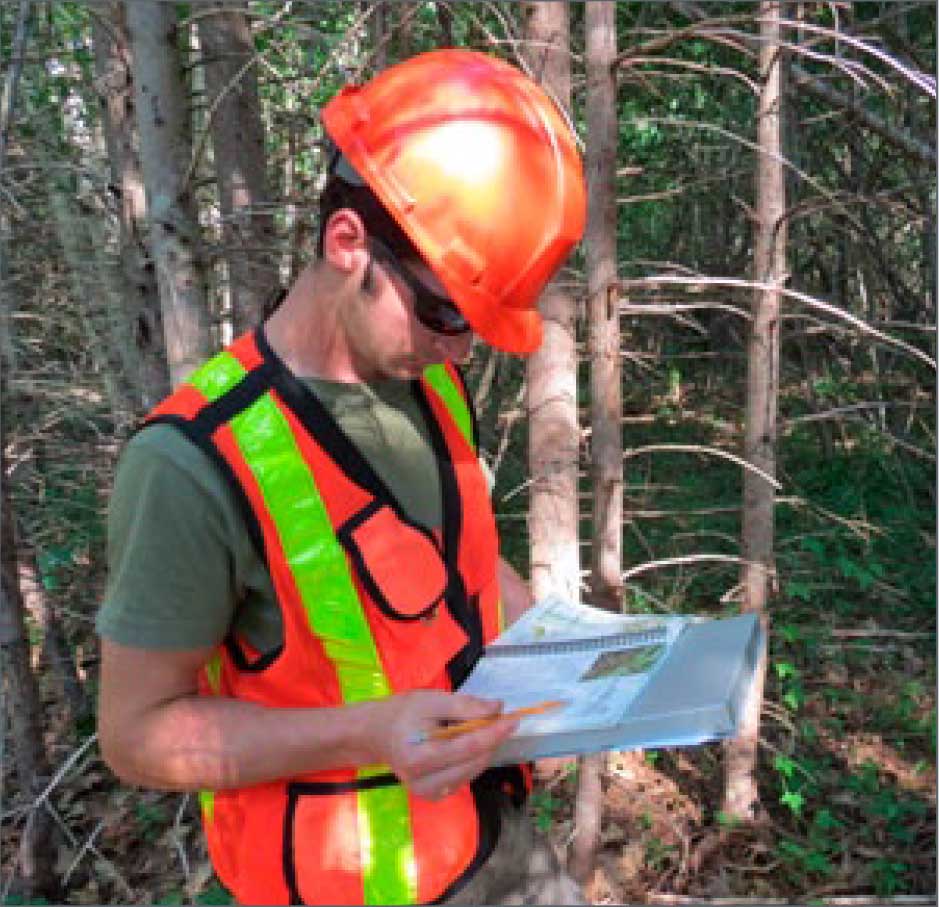 |
| Using Nova Scotia's Forest Ecosystem Classification guide is an essential step in making effective harvest prescriptions |
If timber production is an important value to you, harvesting trees is unavoidable. How you go about harvesting is a significant decision which may involve alternate choices. It is always a good idea to begin by classifying your forest ecosites
Forest Growth and Succession
To help in understanding how forests grow and reach a stage at which trees are ready for harvest, knowledge of a few terms is important.
We have discussed how site conditions influence the types of forest vegetation that become established on a site. Forests are not static communities. They are constantly changing in accordance with successive patterns of vegetation growth and natural forces which shape their structure. These changes can be subtle, such as a slowly decaying tree that eventually falls. Or they can be as dramatic as a hurricane tearing through a forest, toppling trees like pick-up sticks. These forces are called natural disturbances, and they often determine the future composition and structure of our woodlands.
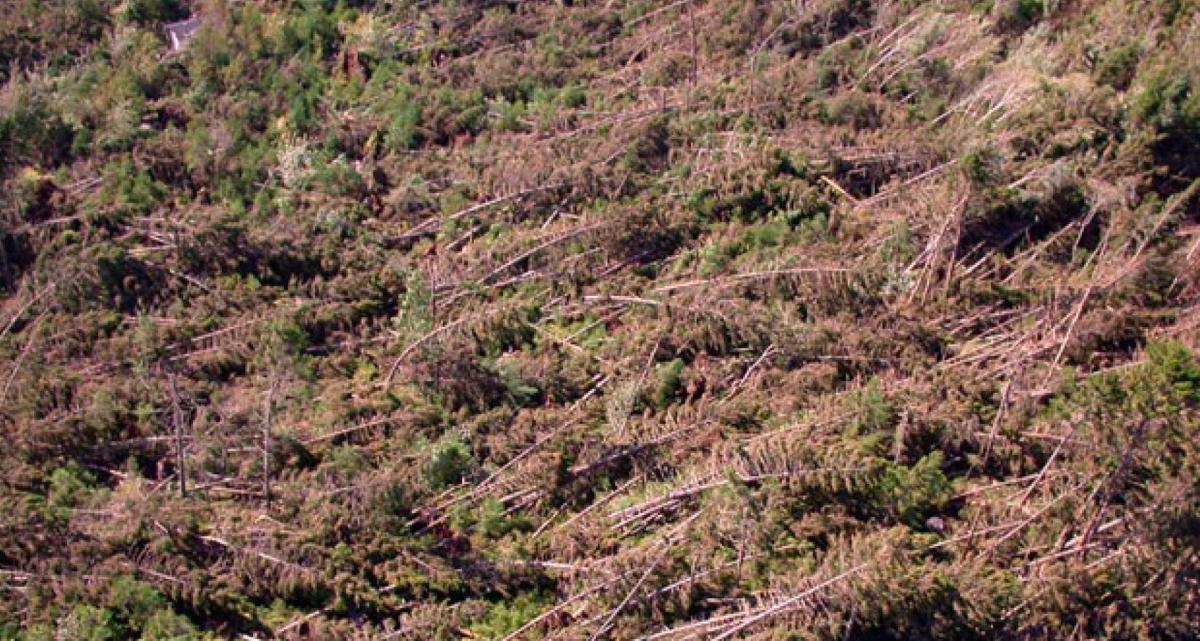 |
| Hurricane damage. Photo courtesy of NSDNR |
In Module 7 we learn that, over time, forest communities develop in an orderly and predictable way. This development - called succession - usually involves changes in species and ecological processes in the community, and is governed by disturbance and tree longevity and shade tolerance. At any
point in time, successional development of a forest community is in one of three stages: early, middle or late successional stage.
successional stages
In an early succesional stage, trees are often fast- growing, shade-intolerant species that vigorously colonize sites that may have been harvested, burned by fire, or cleared for agriculture or other development. Examples of these tree species include:
- Trembling aspen
- White birch
- Gray birch
- Red maple
- Jack pine
- Tamarack
- Red pine
Other, more shade-tolerant species may become established at the same time as shade-intolerant species, but can slowly develop in the shade cast by the taller, faster-growing trees. These can include:
- Balsam fir
- Eastern hemlock
- Red spruce
- Sugar maple
- Yellow birch
- White ash
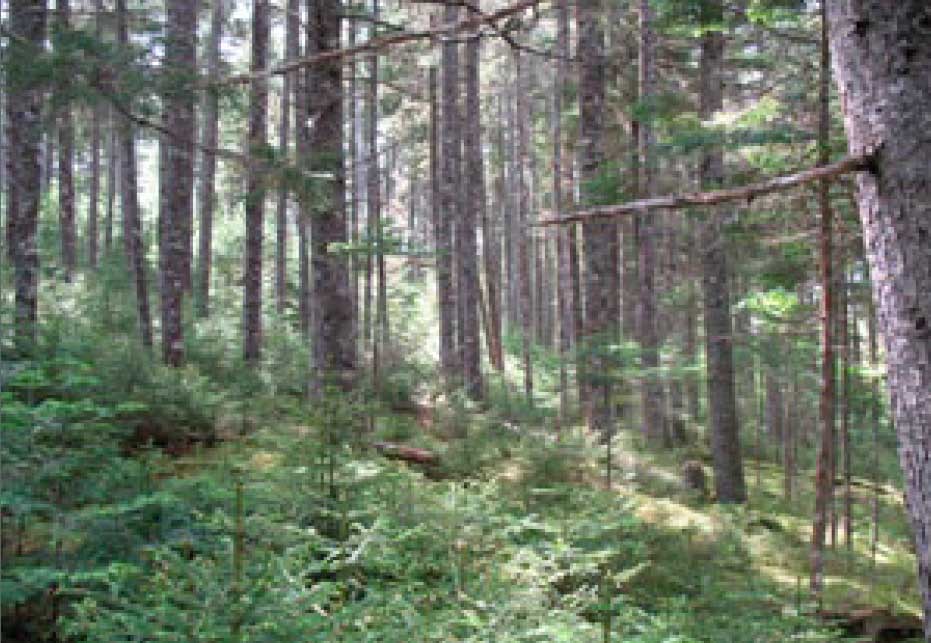 |
| Healthy and vigorous red spruce |
Black spruce is a significant tree species in the forests of Nova Scotia. While it may not be considered a part of the “traditional” Acadian forest, it occupies an important place on the landscape of our province. Sites that may be too wet and nutrient-poor for other tree species may support, and repeatedly regenerate to, stands of black spruce
It is important to note that not all trees are the same size when the forest community is still in an early successional stage. While most of the trees in the community are close to the same age, the more vigorous trees may be much larger than those growing in shade.
As decades pass, an early successional stage becomes mid-successional. Changes in the community are reflected in a shift in tree species, as more shade-tolerant, longer-lived trees begin to replace the fast-growing shorter-lived species. Balsam fir, red spruce and red maple may replace the trembling aspen, white birch and grey birch. The mid-successional stage usually contains a mix of characteristics of both the early- and late- successional stages.
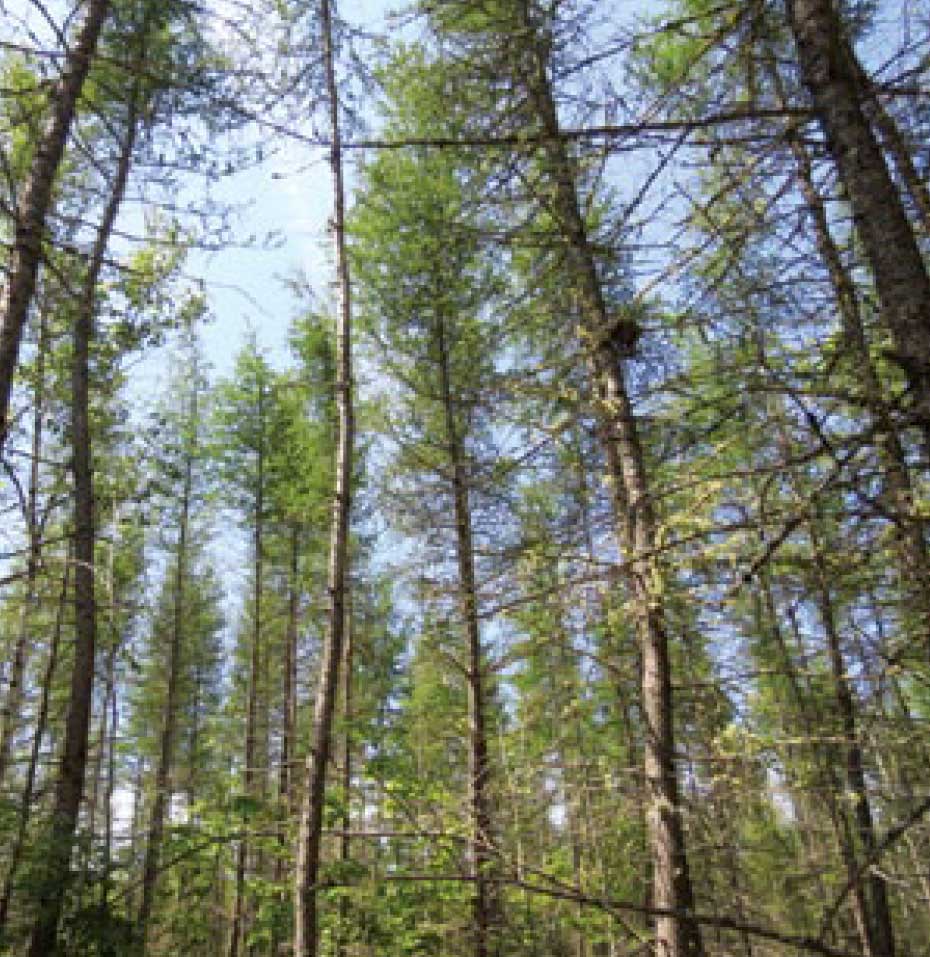 |
| Early successional stand of tamarack |
Late-successional communities are often composed of mostly long-lived, shade-tolerant tree species that become established decades – even centuries – after an early-successional forest. Red spruce, eastern hemlock, sugar maple, yellow birch and beech are examples of species that are found in late- successional forests, although they may not all be found together. Late-successional hardwood stands, for instance, can be composed primarily of sugar maple, yellow birch and beech, while containing few other species.
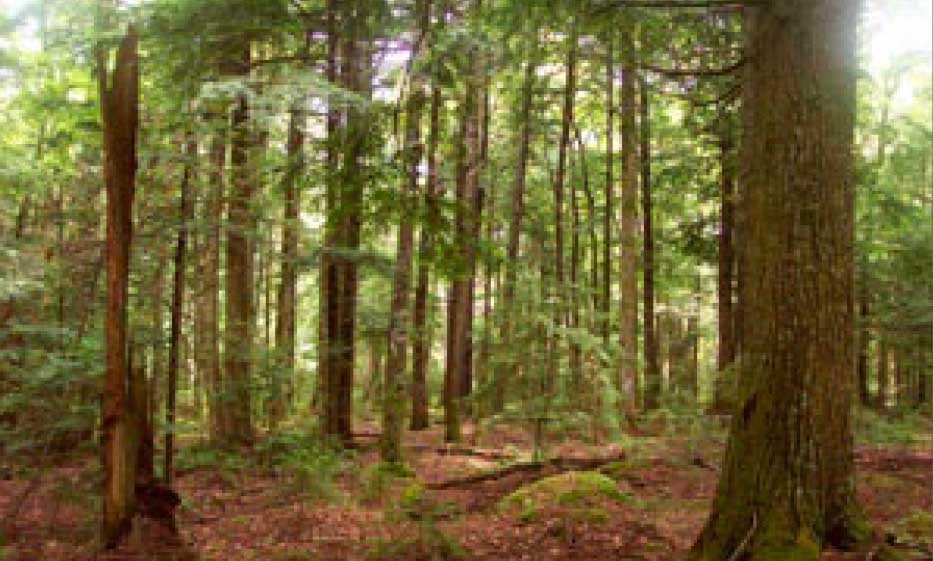 |
|
Late successional stand of hemlock and yellow birch. Photo courtesy NSDNR |
Natural disturbance
Nova Scotia is uniquely posed on the continent of North America. Jutting out like a thumb into the North Atlantic, the province is surrounded on at least two sides by hundreds of miles of open sea. Ice and snow slam into our shores during winter. Sleet batters our forests in early spring, sheathing trees in ice crystals that snap twigs and break branches. Summer sunshine is replaced by autumn rain and gales that every few decades turn into high-energy hurricanes, hammering huge swaths of trees to the forest floor. These seasonal disturbances are not so subtle, and are fortunately rare – but they do occur.
More obvious are the human disturbances that impact forests, such as land-clearing, grazing and forest harvesting. Sometimes disturbances are the result of a combination of human-caused and natural events. In many areas of the province, abandoned fields that were cleared many years ago now support stands of white spruce. An insect called the spruce bark beetle has infested many of these spruce stands, resulting in widespread mortality of the trees. Left alone, these stands eventually fall apart, creating conditions for the establishment of other vegetation.
Forest fires were more common 200 years ago than they are now. When land was being cleared for agriculture, entire forests were burned to make clearing easier. As railroads were built across the province, steam engines and sparks from steel wheels often started fires in the brush adjacent to the tracks. We still see evidence of these fires today, in forest stands that have developed in the burned- over areas.
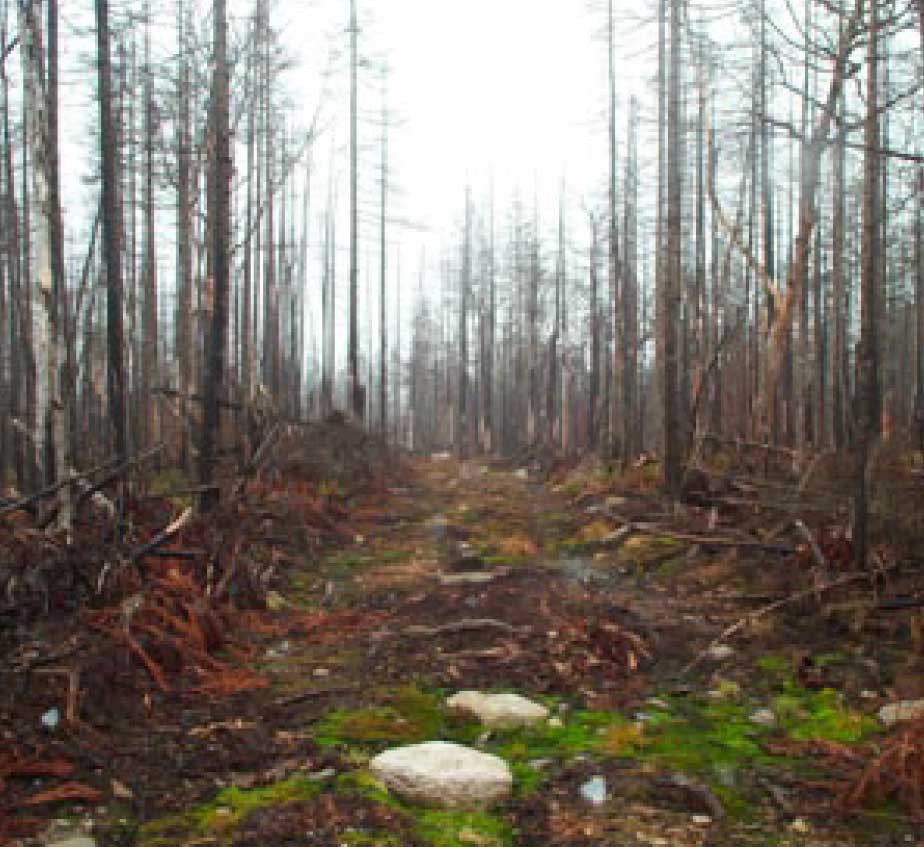 |
| Fires can be large natural disturbance events. Photo courtesy of NSDNR. |
Fires start naturally when lightning strikes a site that may contain combustible material. This could include standing dead trees (called snags) that easily combust under the right conditions.
During the last 50 years we have developed effective fire suppression techniques that reduce the likelihood that a forest fire will rage out of control over large areas. As a result, forest fires are no longer a significant form of natural disturbance in Nova Scotia.
A less obvious form of natural disturbance is the gentle progress of decay in a tree that may occur from wounds in its bark, or root-rot lesions from fungi that live in the soil. The decline of a tree can be nearly unnoticed, until one day it topples to the ground. The tree may break off above the ground, or tear the forest floor as the great mass of roots hinges upwards, revealing the secrets of the soil. Sunlight suddenly replaces shade, and an opening is created in the forest. Insects, centipedes and millipedes all scurry for cover as the roof is suddenly torn from their home. Birds flock to the feast. It is a fresh new start for some organisms that prefer sunlight over shade.
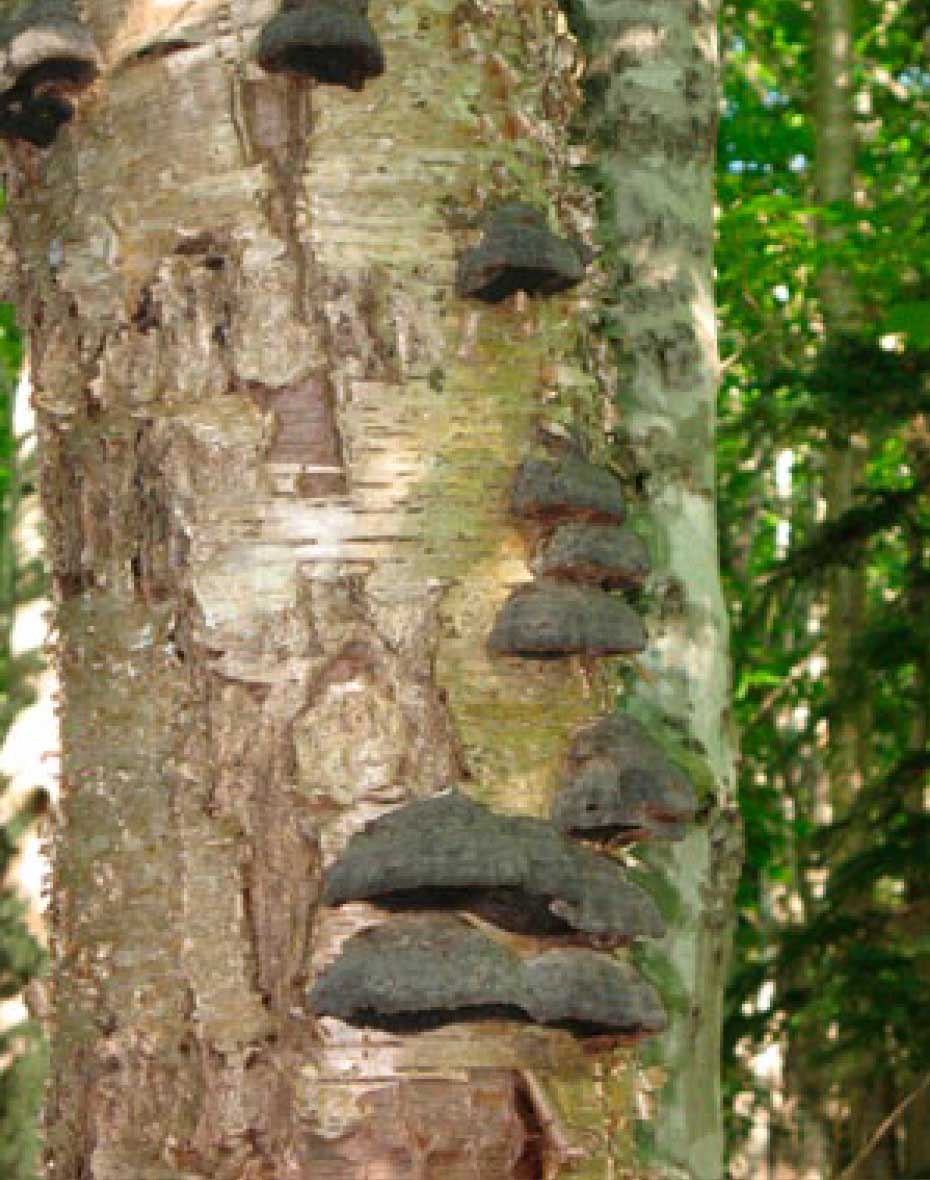 |
| These conks indicated advanced decay in this yellow birch. |
Such small-scale disturbances are constantly occurring over our forest landscape. As openings occur, other species colonize these sites, perhaps afforded an opportunity by mineral soil unearthed by disgorged roots, or attracted to organic material and moisture provided by the trunk of the tree laying on the forest floor. Blue-spotted salamanders and red efts may seek shelter here, while wood lice mine the decaying wood for nutrients. In its death – whether slow or sudden – the fallen tree has created conditions suited to a procession of new life close to the surface of the soil.
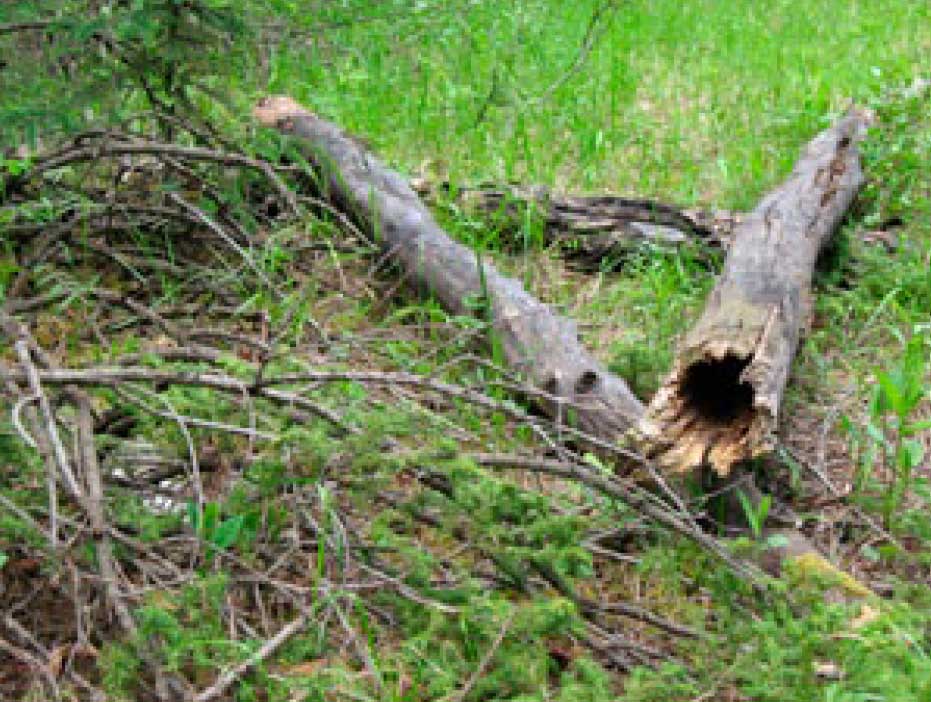 |
|
Coarse woody debris provides essential shelter and nutrients for many organisms |
In this damp, dark interface between the soil and air, a critical layer of activity occurs. Earthworms and white-laced strands of fungi decompose decaying wood and convert it to forms of food that other organisms can use. Twigs, branches, needles and leaves accumulate on the surface of the soil, providing a constant shower of organic matter that is used by bacteria, fungi and insects – the building blocks of a healthy forest.
Using Your knowledge of forest succession and natural disturbance
We’ve discussed how a good understanding of the succession dynamics of your woodland will assist you in determining whether harvesting isappropriate. We’ve looked at natural disturbance patterns, including small gap disturbances and larger disturbances that accompany events like hurricanes and insect outbreaks. It is time to look at your woodland management plan and decide the scale of harvesting that may be appropriate.
Even-aged vs. Uneven-aged Stands
It is important to determine whether the stand you plan to harvest is even-aged or uneven-aged.
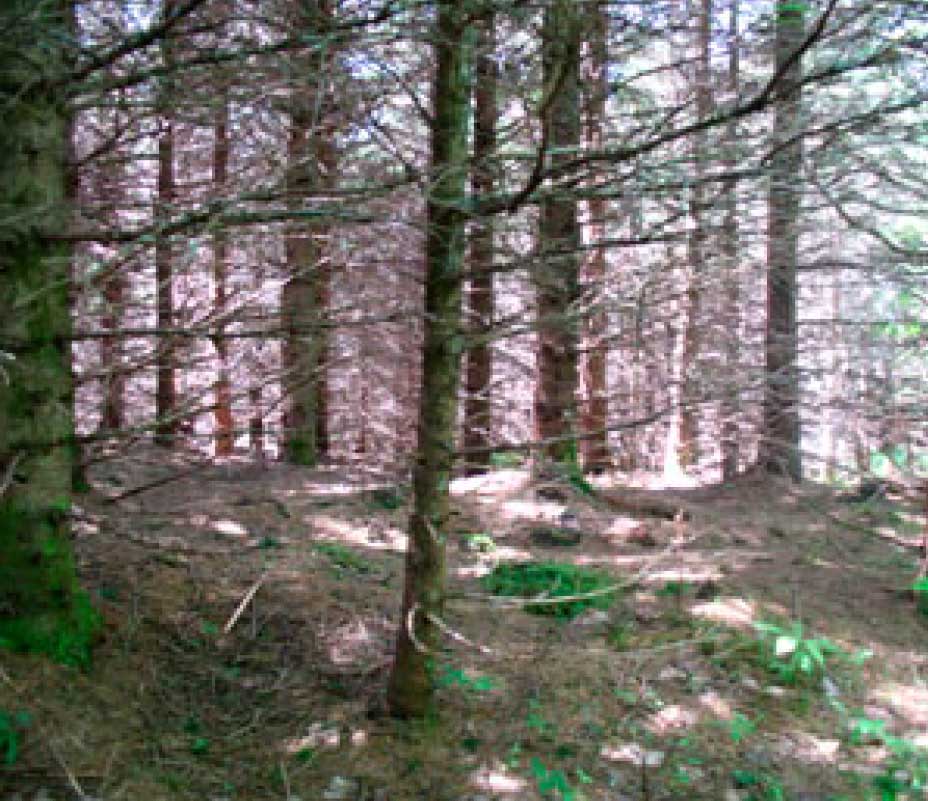 |
| An even-aged stand of old-field white spruce |
Each tree species has an age of maturity, beyond which it will not increase in timber value. Of course, timber value is not the only value that you may have for your woodland. The importance of overmature trees and their value as standing dead wood, or snags, cannot be overestimated. For example, some species such as shade-tolerant hardwoods, can make very good cavity trees, since the inner wood may decay more quickly than the wood close to the bark. This results in a hollow tree that can be used by wildlife.
Even-aged stands are characterized by trees that have become established within a few years of a stand-level disturbance, and are close to the same age. Generally
speaking, an even-aged forest becomes more susceptible to natural disturbance as it grows older. As trees grow taller and their crowns grow larger, they become less windfirm and more disposed to windthrow. As balsam fir trees weaken with age they become more susceptible to widespread outbreaks of spruce budworm (Choristoneura fumiferana), a natural event which occurs in regular cycles in Nova Scotia.
Uneven aged stands contain three or more age classes of trees that have developed from small- scale disturbances. There may be a mixture of all sizes of trees together on the same site. These stands are more complex than even-aged stands, and any management approach should be carefully considered before it is implemented. Again, planning is very important.
 |
| An uneven-aged stand of white pine and red spruce |
Healthy seedlings growing in the shade of larger trees is an important feature of uneven-aged stands. The seedlings are usually shade-tolerant species such as red spruce, eastern hemlock, sugar maple, yellow birch and beech.
These stands, in the absence of large-scale disturbances, can retain their uneven-aged conditions for many decades – even centuries – as individual trees, or small patches of trees, die or are blown down and openings are created in the forest canopy. Some regeneration may already exist in the area of the opening, and these trees often have an advantage over newly-established seedlings as they rapidly expand into the available growing space. The battle for light and space is constantly being waged in an uneven- aged stand, and shade-tolerant and long-lived tree species clearly have an advantage in these conditions.
We have discussed natural disturbance at length because it is important to understand the dynamics that take place within your woodland over time. It is especially important to consider how a stand will regenerate, and with what species. Harvesting can be used as a tool to promote regeneration, and you should ponder what you would like the next stand to look like.
We’re now ready to discuss harvesting approaches in the context of natural disturbance.
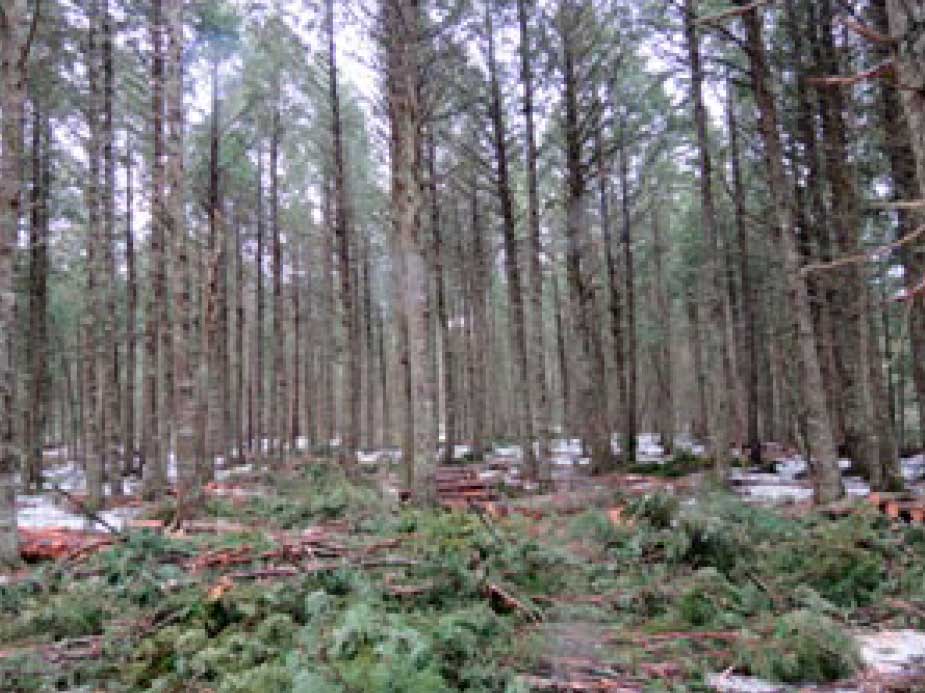 |
|
A partially-harvested stand of hemlock |
Module 2 - Lesson Two Quiz
| Questions: | 10 |
| Attempts allowed: | Unlimited |
| Available: | Always |
| Pass rate: | 75 % |
| Backwards navigation: | Allowed |
Lesson Three - The Selection System
|
|
| A harvesting processor removing balsam fir from a mixedwood stand |
Harvesting Equipment
Much of the equipment that is used in harvesting timber in Nova Scotia is highly mechanized and requires skilled operators. Most operators undergo training to learn how to operate equipment efficiently and effectively. Modern equipment requires technical knowledge and good operators take pride in their work.
Although less common, harvesting trees manually by chainsaw is still present on many private woodlands. Even in mechanical operations, chainsaw operators are valuable for felling residual trees and those trees which a processor cannot handle, such as trees with heavy limbs or crooked stems.
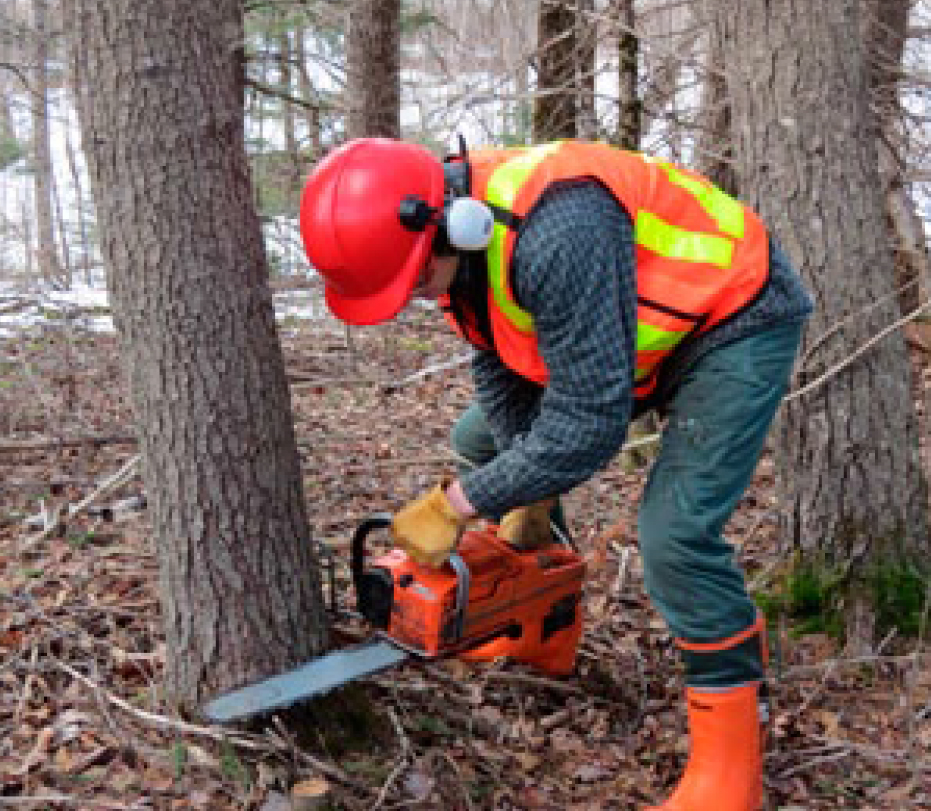 |
| Chainsaw operators are more difficult to find nowadays, but many would cut a tree no other way |
There are advantages and disadvantages to both mechanical and manual harvesting methods:
Mechanical Harvesting – advantages
• Greater volumes of wood can be harvested in a relatively shorter period of time
• Work environment is less physically demanding with better ergonomics
• Work environment is safer
• Dimensions of product are often more consistent
Mechanical Harvesting – disadvantages
• High cost of equipment
• Relatively large harvest area is often required to justify cost of moving heavy equipment
• Sites and seasons must be chosen with care to avoid soil compaction and rutting
Manual Harvesting – advantages
• Ability to harvest trees in a relatively small area
• Low cost of equipment
• Flexibility of extraction method (forwarder, skidder, horse or other small extraction equipment)
• Where product value is high, as in the case of hardwood veneer, sawlogs and specialty products, operator is able to custom-cut the product
Manual Harvesting – disadvantages
• Physically demanding
• Relatively low wood production
• Can be difficult to maintain skilled sizable crew
• Hazardous work environment
• More time is needed to cover large areas of harvest
It should be noted that the manual harvesting method may still require heavy wood extraction equipment to be transported to the work site, and the use of such equipment will be dependent on site conditions and other factors.
Wood Extraction
Careful consideration should be given to the method, location and direction that wood will be extracted from a harvested site. The site should be thoroughly inspected prior to harvesting, in order to determine the best extraction results.
The location of roads in relation to the harvest site is an important factor. If wood is to be extracted a distance of less than 400 meters, smaller extraction equipment or animals can be considered. For greater distances, equipment must be larger to transport higher volumes of wood at increased speeds.
Horses and oxen
For relatively short extraction routes over fairly flat and smooth ground, livestock such as horses and oxen are sometimes used. Although uncommon, their use is usually at the request of the landowner, because they are seen as good examples of low- impact forestry. These animals quickly become accustomed to the sound of a chain saw and soon learn to work with very little direct supervision. Most operators prefer to work the animals in fall or winter when the air is cool and flies are absent. Well-trained animals can be wonderful to watch.
 |
| A unique team of oxen |
Skidders
The use of skidders for wood extraction has declined over the last 20 years in Nova Scotia as cut-to-length operations become more common. For woodland owners who wish to carry out their own work, a used skidder can often be found at reasonable prices.
A cable skidder has a winch mounted high on the rear of the vehicle, from which a cable with several chokers can be used to pull timber toward the skidder. An obvious advantage of a skidder is that the machine can remain on or close to an extraction trail while winching trees from areas of soft ground. Timber can also be winched up steep slopes without the dangers associated with operating heavy equipment on such terrain.
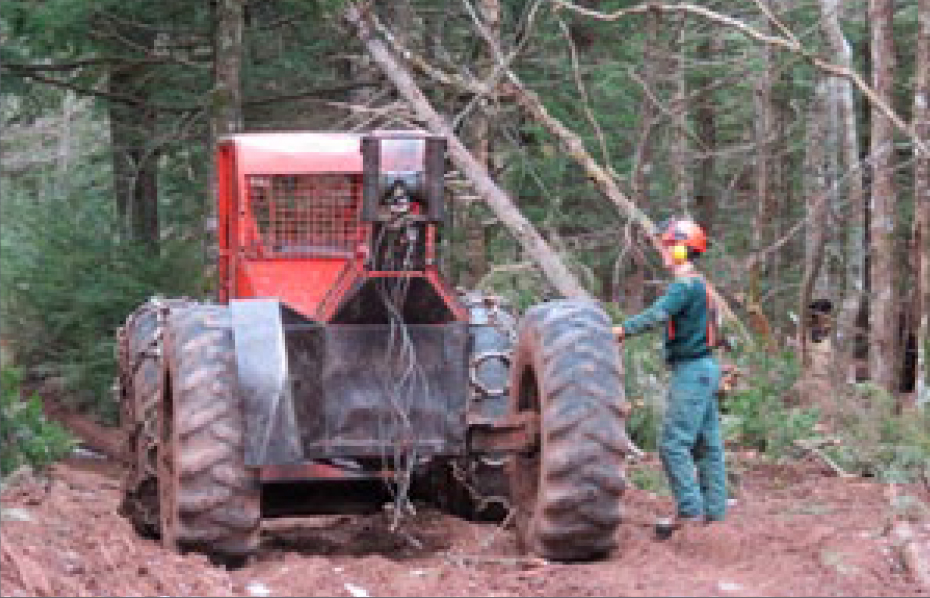 |
| A skidder can be a good choice for wood extraction on small private woodland |
A skidder can be outfitted with a plow for clearing snow, and can be used for dragging site preparation equipment such as shark-fin barrels.
While a skidder is versatile and has many advantages over other extraction methods, it cannot easily create piles of roadside wood convenient for loading on trucks. For this work, a forwarder can more capably pile wood.
Farm Tractors
Farm tractors can be versatile and useful machines on small woodlands. They can be used in a variety of ways, including wood extraction and loading. With a winch mounted on the rear, they can be used in a manner similar to skidders. Tractors are neither as heavy nor as rugged as skidders when used in forestry work. With additional equipment such as cab protectors and skid plates added, a tractor can be “beefed up” to work in the woods. An accessory that is useful and popular is the loader-trailer, which can be used to extract and pile wood in a manner similar to a forwarder, at a much lower cost.
Forwarders (Porters)
By far the most efficient vehicles for extracting cut- to-length wood, forwarders are widely used in most commercial forestry operations. With the capacity for carrying at least 8 tonnes of wood to the side of the road relatively quickly, a forwarder has the capability to keep pace with a harvesting processor. For larger operations, two forwarders are often used.
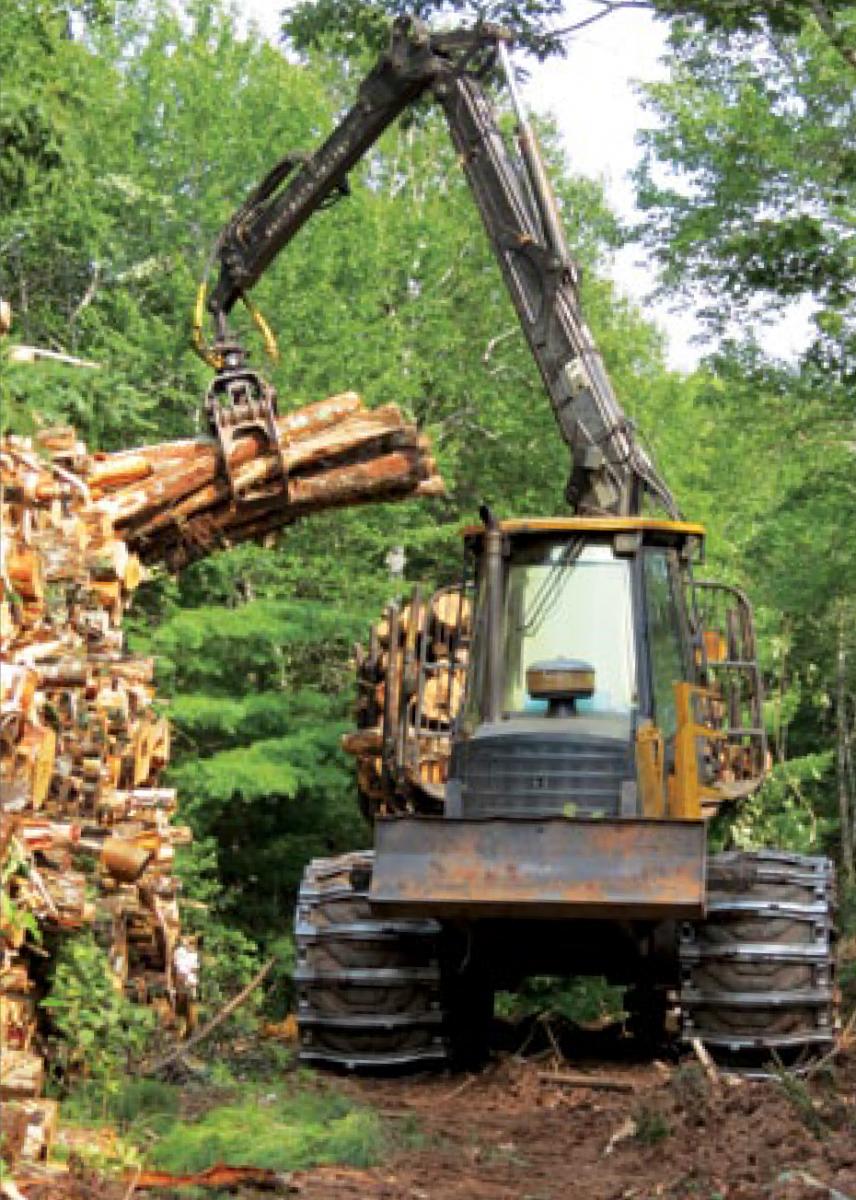 |
| Forwarder piling hardwood |
By literally carrying the wood on its back, a forwarder keeps wood clean and can travel quickly. Modern forwarders have six or eight wheels and can be outfitted with tracks that further reduce soil compaction and rutting.
A forwarder can be brought on-site to collect wood at any time following a harvest by a processor or a crew of chainsaw operators. As long as the wood is not buried in deep snow, a forwarder operator can pick it up and extract it to roadside.
In selection harvesting, where the felling may be done by chainsaw, the layout and configuration of extraction trails is particularly important, since a
forwarder must get very close to the wood it is to collect. If the felling is done with a processor, in most cases a forwarder can use the trails created by the harvester.
Harvesting Contractors
Woodland owners who do not wish to cut their own wood hire forestry contractors to do the work for them. Most contractors have a good knowledge of wood markets and will streamline their operations to accommodate them. When working with a contractor it is a good idea to be as diligent as possible, and implement a written contract, to protect both yourself and the contractor. Refer to Module 14, “Working with a Woodland Contractor”, for further information.
 |
| Every job should be discussed in detail with the harvesting contractor |
Wood is usually sold to a contractor as “standing on the stump”. It is prudent to obtain more than one estimate of what your wood may be worth before it is cut.
Sorting Your Wood
Perhaps one of the most overlooked aspects of timber harvesting is proper sorting. A drive on any gravel road in Nova Scotia will indicate examples of the
consequences of poor planning: neat piles of decaying wood that have been delivered and sorted at the side of a road or landing, but have never been trucked.
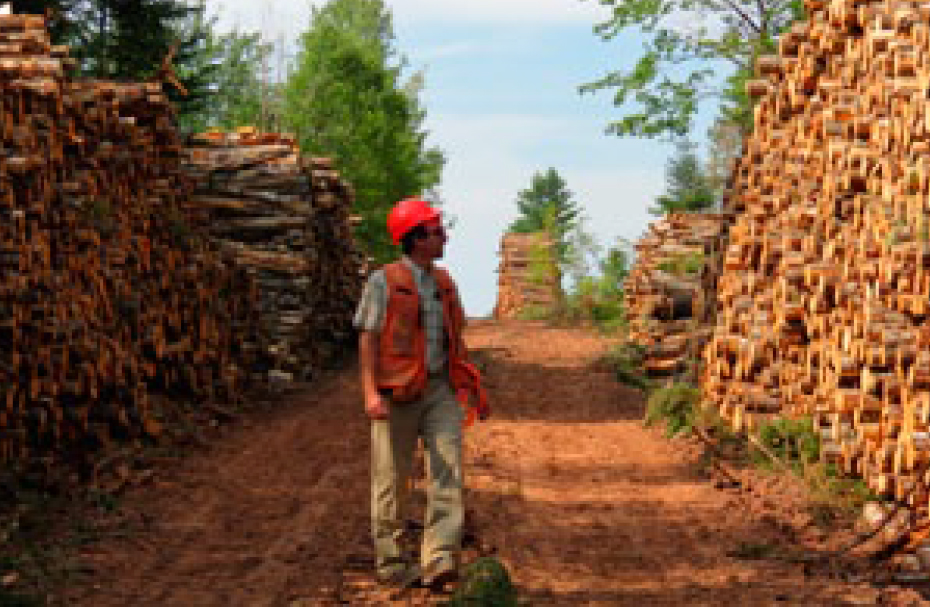 |
| Neatly sorted piles can add value to a harvest |
This problem is easily avoided by having a good knowledge of wood markets and planning your harvest accordingly. Although it may seem extensive, up to 12 different product “sorts” can result from a single harvest, depending on tree species, quality and size. In some woodlands, a typical harvest could include:
• Three or more different lengths of softwood logs
• First grade softwood pulpwood
• Second grade softwood pulpwood
• Softwood studwood (usually for 2x4 or 2x6 lumber)
• Aspen (for oriented strand board)
• Tamarack (for fenceposts)
• Fuelwood
• Low-grade softwood and hardwood for chipping (biomass and wood pellets)
• Hardwood sawlogs and veneer logs
• Hemlock (for bridge stringers)
It is essential to keep in mind that sorting wood at roadside costs money, and you should have markets already secured that make the time and expense of sorting worthwhile. If you are sorting the wood yourself, the sorting must be done in an area that is easily accessible to trucks, usually semi-trailers. These trucks (also called tractor-trailers) are common for hauls over 100 km, or to pulpmills and larger facilities. Tandem trucks are still widely used in Nova Scotia for shorter hauls to sawmills, or for fuelwood delivery.
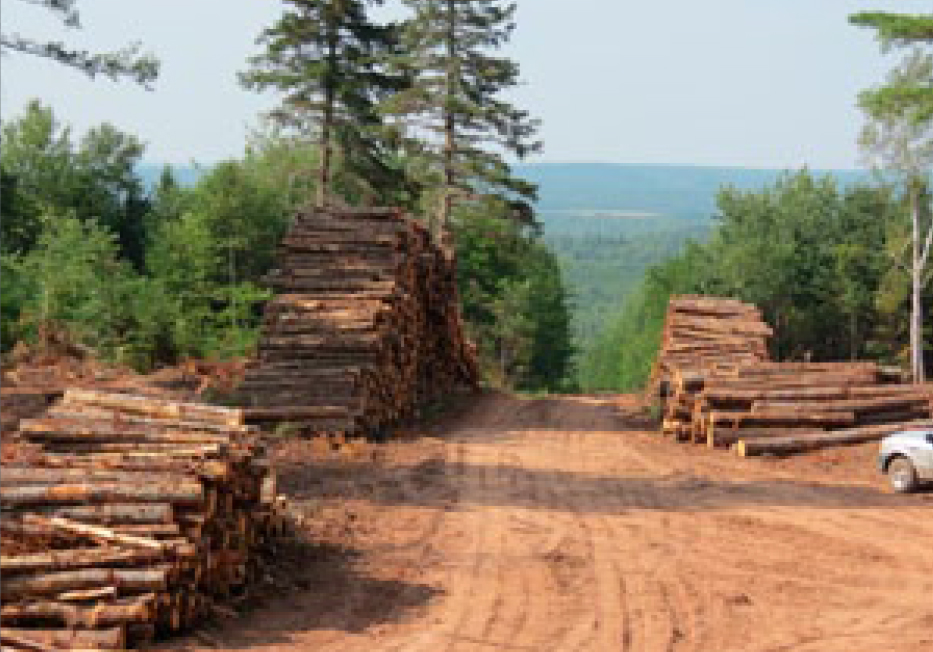 |
| Adequate landings are essential to allow large trucks to turn |
It should be kept in mind that not all trailers are equipped with loaders, and some trucks must be loaded parallel to another truck with a loader. This makes the organization of your landing zone of paramount importance.
When planning any harvest, it is prudent to maximize the return on all forest products. Often, this will result in the sorting of fewer products if markets dictate fewer opportunities. Being responsive to markets is essential to good revenue returns, and it is wise to check local markets before embarking on any harvesting operation. This may involve calling local sawmills, pulp mills, and firewood processors. Or you can simply contact a wood broker, who will do the marketing for you, usually for a fee.
Marketing Your Forest Products
Knowing where and when to sell the wood products that your woodland produces, is absolutely vital if you are planning to harvest timber yourself. Markets exist for nearly every species and size tree that you wish to harvest, but you often need to do a lot of searching.
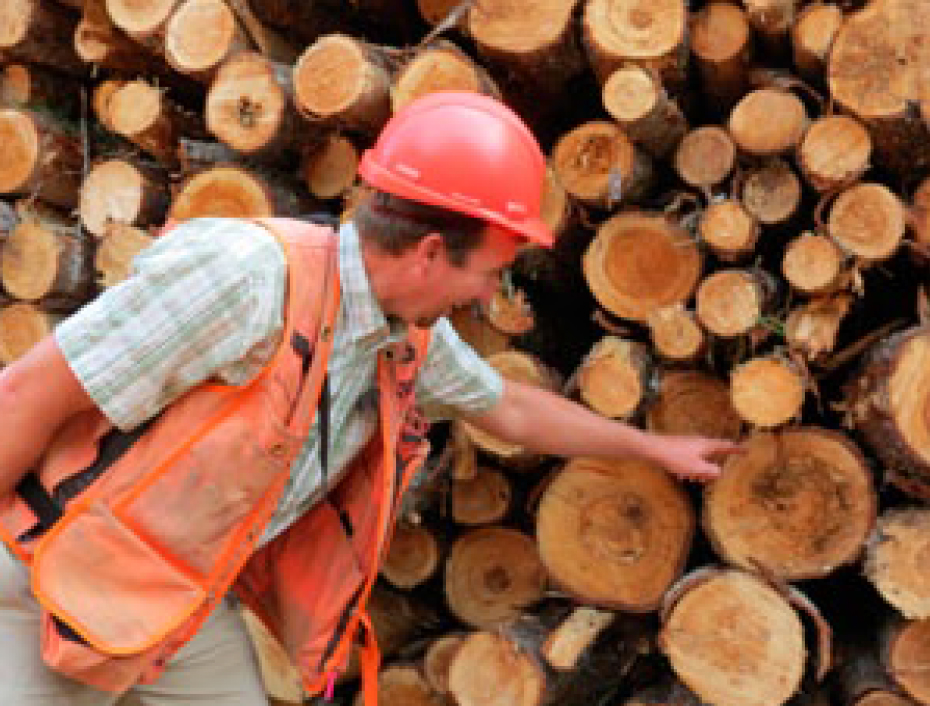 |
| Wood must be graded and sorted for the available markets |
Wood is usually sold by weight (tonne) or volume (cubic meters or cords). Some sawmills still purchase wood by thousand foot-board measure. It is important that you know how to convert metric units to Imperial units – and back again – since not every buyer will purchase wood in the same units as the next.
When hardwood trees are to be harvested for lumber or veneer, it is advisable to ask the mill to send someone to appraise the standing trees. There is a bewildering array of specifications that, if not followed precisely, can negatively influence the prices that you will receive for the wood. For example, an effective log grader can tell you exactly how long to cut the wood for each diameter class, as well as appraise the trees for defects and how to cut the wood for maximum volume and value. A skilled hardwood grader can be your best friend when you wish to produce high-quality hardwood logs.
 |
|
Hardwood should be graded and measured “on the stump” if possible |
Using a broker
Some landowners that do their own harvesting sell their wood through forest products brokers, who will often purchase all the harvested wood and redirect each product to the appropriate mill. Although the buyers usually charge a brokerage fees for this service, it can be well worth the time and effort saved in thoroughly researching the available markets. A broker has an expansive knowledge of the flow of wood products across the entire marketplace, and can be a valuable source of information for a woodland owner.
Every potential wood market has its own set of criteria and standards. These include acceptable species, dimensions of the harvested wood, tolerance for defects and knots (particularly important in hardwood lumber sales), and trucking rates and distances to mills. All of these factors affect wood prices, or even whether a mill will accept the wood. A wood broker has the intimate knowledge that is needed to effectively market your wood.
Access roads and trails
Without good road access it is difficult to effectively harvest a forest stand. If the stand being harvested is more than 300 meters from the landing zone, extra forwarding costs will likely be the result. There is also increased potential that forest soils will be damaged. This, in turn, will reduce the stumpage value of the standing timber. It also results in extra wear and tear on equipment.
If you are forwarding the wood yourself, the size of the forwarding equipment limits the distance over which the wood can be transported. Small-scale equipment such as farm tractors with power trailers is generally restricted to operating within 400 meters of the landing zone. Horses and oxen are typically limited to the same distance.
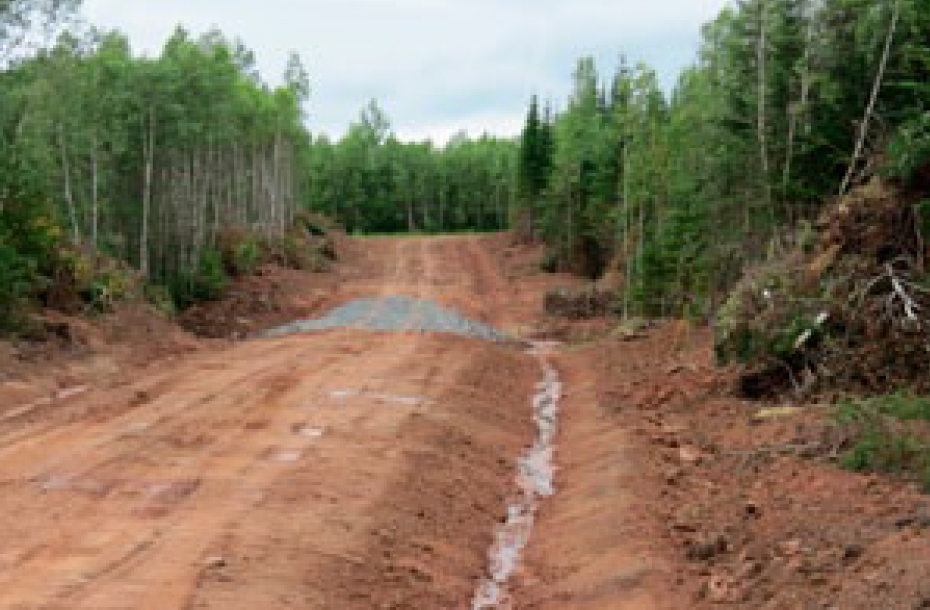 |
| This newly-constructed access road will be essential for safe and efficient harvesting |
With larger forwarding equipment such as skidders and forwarders, distance to the landing zone can be increased. While cable skidders are not as common as they once were, they are still effective in dragging cut- to-length, random-length and tree-length wood to the landing zone. Older-model skidders are popular with woodland owners that have a knack for mechanics. Skidders can be also outfitted with snowplows for clearing forest roads. They are particularly useful for extracting single large trees from the woods by cable, or for winching trees up steep slopes.
Modern forwarders have the capability to forward wood for long distances (up to a kilometer). With most forwarders able to carry more than 8 tonnes (4 cords) of wood, it is important to locate extraction trails that will afford the most straightforward routes of travel. Watercourses, wetlands and rugged terrain will also influence the location of forwarder trails.
For more information on forest road and trail construction refer to Module 11.
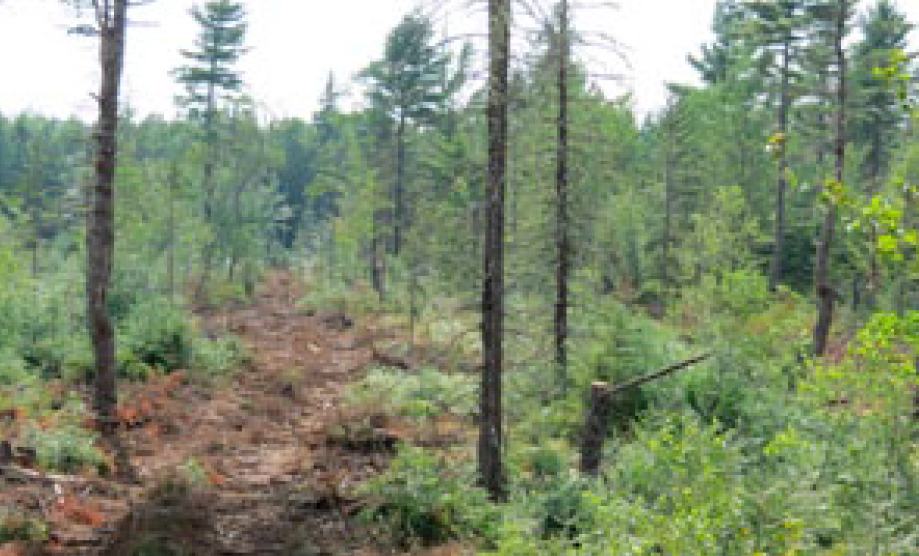 |
| Forwarder trails should be located to avoid damaging advanced regeneration. |
Case Study 1
The MacIvers had owned farmland in Pictou County for more than two centuries. Since the original MacIver had emigrated from Scotland in 1793, the farm had seen seven generations of families.
Although many acres of MacIver land had been carved off over the years, Ian still owned 300 acres (121 ha) of the original farm. More than two-thirds of it was still agricultural fields.
As the beef industry had declined, whole farms had been abandoned. On the MacIver place, the upper pastures had fallen into disuse. Ian’s father could recall the small patches of speckled alder that first became established on the moister sites of the pasture, where the cattle used to gather during the hottest summer days. Over the rest of the pasture, white spruce had seeded and grown. Patchy at first, then covering the pastures like a thick green carpet, the spruce seemed to out-grow everything else. Pasture spruce, Ian’s father had called it. Cat spruce, one of the neighbors had termed it. And those were the polite names.
For more than fifty years the spruce had grown, without tending or management. “The Desperate Place,” his father had called it before he died. Many of the trees were open-grown, with branches growing from the whole length of the trunk. These limbs were long and many of the crowns were turning reddish-orange, a sure sign that something was amiss. Ian was concerned, since he didn’t want this malady to affect his plantations. He called a local forest professional to ask him to take a look.
Alex the forest technician didn’t take long in reaching a conclusion. “Spruce bark beetle,” he stated, and showed Ian the tiny exit holes in the bark where the beetles had fed, pupated, emerged as adults and escaped. Alex pulled off a patch of bark and Ian could see the insect galleries etched into the wood. With sap prevented from carrying water and nutrients between roots and crown, the needles could not carry out photosynthesis and the tree was dying.
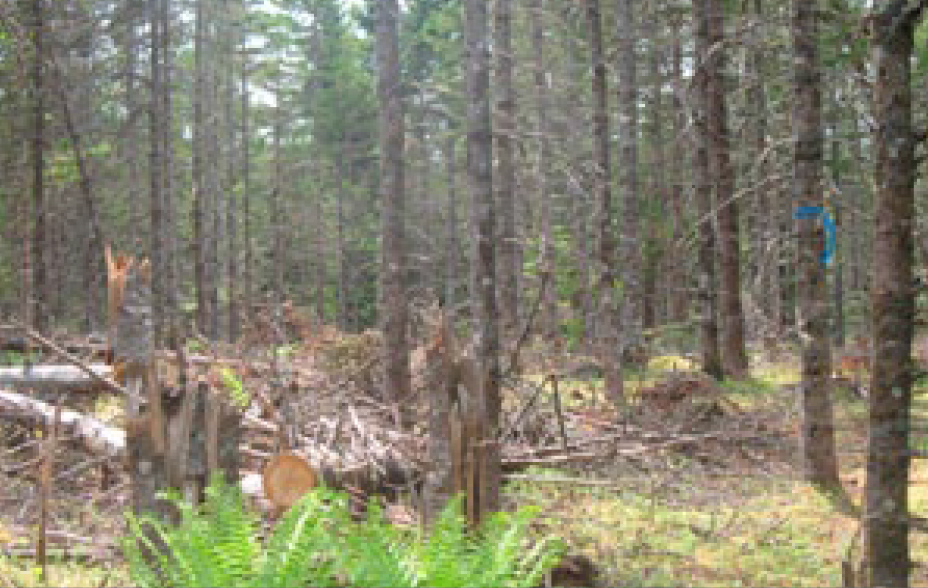 |
The forest technician recommended harvesting the stand as soon as possible to prevent further mortality in both this stand and adjacent ones. Ian wondered whether he should harvest only the affected trees. “You’ll be back harvesting again next year,” said Alex, “and you’ll likely be cleaning up blowdowns too.” He pointed to the forest floor, where the shallow rooting of the spruce was evident. “If this field was plowed at some time in the past, there is a hardpan layer about a half-meter down, which prevents deep rooting.” Ian could remember his father plowing the fields in the 1960s.
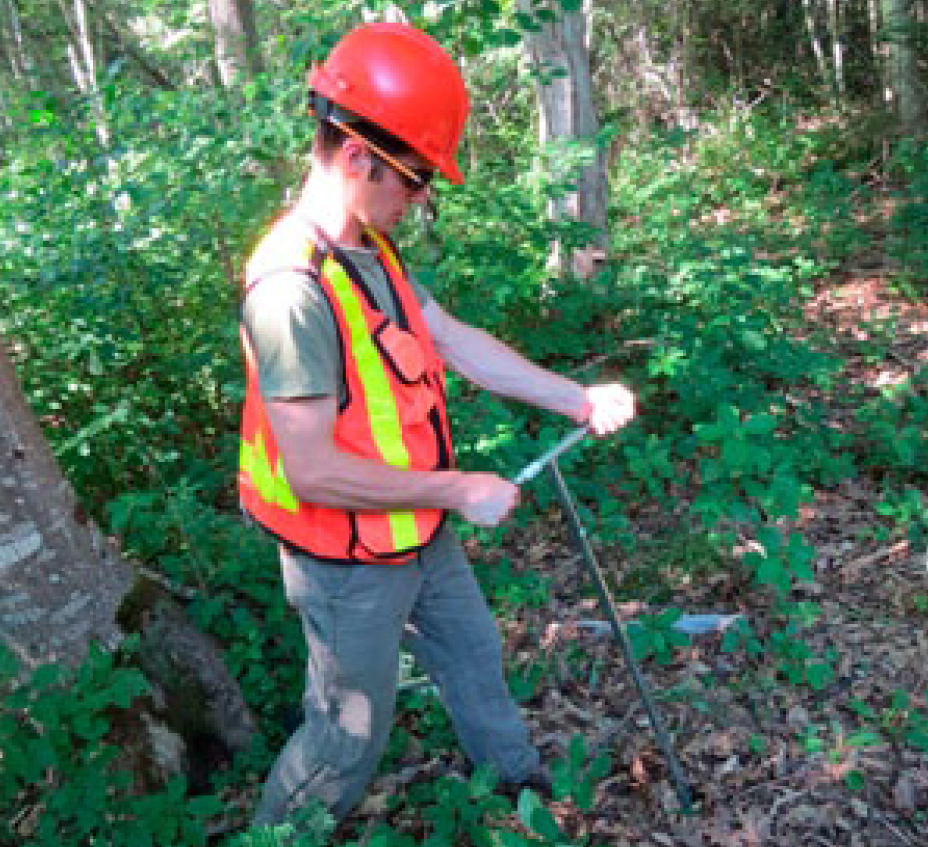 |
Ian watched Alex as the forest technician twisted his soil auger into the ground to take a soil sample. He could see the change in soil conditions at about 40 cm, where the loose upper soil lay on top of a hard layer, which was nearly impervious to tree roots. “That’s the hardpan,” said Alex. “I will carry out some pre-treatment assessments on this site, and they will likely show the same results. After that, I can recommend a couple of good harvesting contractors if you’re interested.”
Ian was indeed interested.
Over the next week two contractors visited the MacIver woodland and Ian was impressed with their attention to detail. Because an old farm road was within 100 meters (312-feet) of the stand, a new road was not necessary. There was a place where semi-trailers could get turned and an area for piling the wood. The road culverts seemed to be in good shape, and a little gravel was all that was needed.
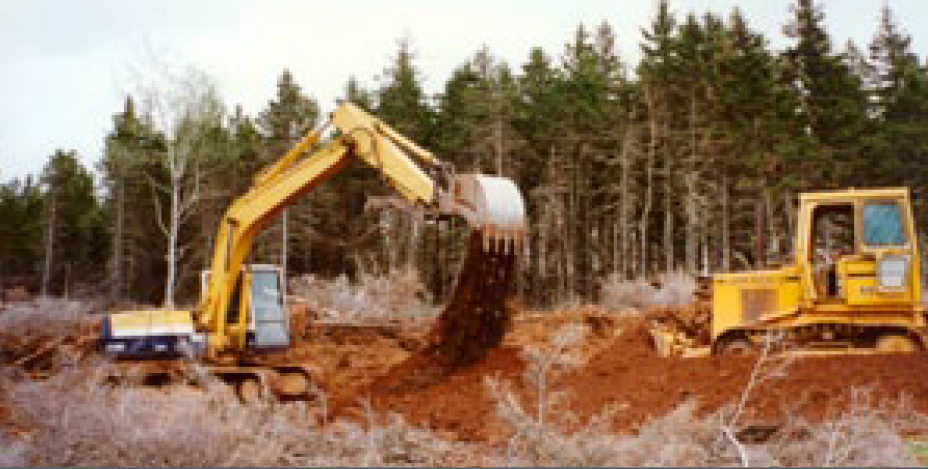 |
Ian knew that he would have to declare his income on the wood when he was paid for it, so he talked with his accountant to sort out the best method of payment. He found he could claim it as farm income and could charge the cost of the gravel against the wood. Both contractors’ offers were similar and Ian settled on a lump-sum stumpage payment with one of them. The contractor indicated that if he damaged the road during the harvesting or trucking operations, he would repair it at no additional charge. Ian could now consider this a hands-off operation, which suited him just fine.
About a month later, a flatbed trailer arrived carrying a harvesting processor. The contractor arrived soon afterward and together with Ian, flagged out the site to be harvested. It was close to 10 hectares (25-acres) in area. Legacy/wildlife clumps would need to be left to meet the provincial wildlife regulations, and they flagged these as well.
That afternoon the harvester began felling and delimbing trees along the edge of the stand. Not surprisingly, the harvester operator avoided cutting several of the largest, limbiest trees. These were left for the forwarder operator, who was also skilled at manual felling by chainsaw.
Ian marveled at the seeming ease with which the harvester cut each tree a stump height and ran the processing head up the trunk to shear off the limbs. The head then back-tracked and cut the trunk at about eight-foot intervals. He later found out that these cuts were determined by an onboard computer, which was optimizing the wood length for studwood. Wood that was too small in diameter, such as the upper trunk, was processed for pulpwood.
The harvester computer handled the tediousness of this cut-to-length system, reducing the operator’s need to make decisions based on the diameter of the wood. The six-wheel-drive vehicle was able to climb the hill as it worked, and soon neat rows of freshly cut wood formed regimented lines up the hillside. The operator had sheared the limbs directly in front of the harvester, and placed the cut wood off to one side, so the harvester had a mat of limbs and brush on which to travel.
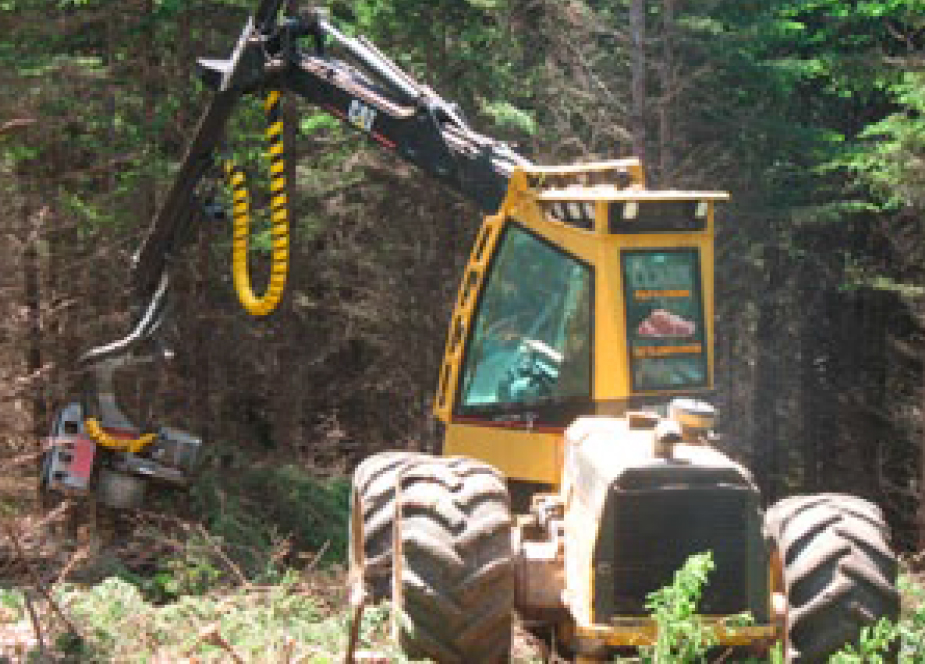 |
Two days later the forwarder arrived, delivered sometime during the night. The harvester had been working 10-hour days, and had a substantial volume of wood ready to be picked up. Ian watched as the forwarder operator travelled the same trail of brush as the harvester, and efficiently used the boom and grapple to load two tiers of wood onto the eight-wheel-drive vehicle.
Once full, it crawled back to the side of the road and off-loaded the wood. Ian could see that each set of wide, tandem tires had tracks attached. With over 10-tonnes of wood, the forwarder left remarkably little imprint on the surface of the forest floor.
Within a couple of days the wood had been piled high on the side of the road. Trucks began to arrive, loading the wood. Nearly all the studwood was trucked first, and then two trucks arrived for the pulpwood, of which there was surprisingly little. Ian counted over fifty truckloads leaving, and knew he didn’t see them all.
A week later the job was finished. The forwarder had caught up to the harvester relatively quickly, and there were two days when the forwarder operator manually felled and delimbed the trees the harvester could not process. There were two islands of trees – flagging tape still attached to the perimeters – left as legacy/wildlife clumps.
Ian thought the site looked barren compared to what it had been, but he remembered that this was once a field. With the trees removed, the ground was remarkably level.
Alex the forest technician had given him the name of a tree planting contractor because - he was surprised to learn – this site would not regenerate on its own for many years. And, Alex cautioned, it would be wise to wait a couple of years before planting, since an insect called the root-collar debarking weevil tended to chew the tender parts of seedlings that were planted too soon after the site was harvested. This was especially the case on white spruce cutovers.
Ian was pleased that the whole operation had proceeded so smoothly. The harvester and forwarder had disappeared the same night they had completed work on the woodland. His neighbor told him the crew was working a few kilometers down the road, performing a selection harvest.
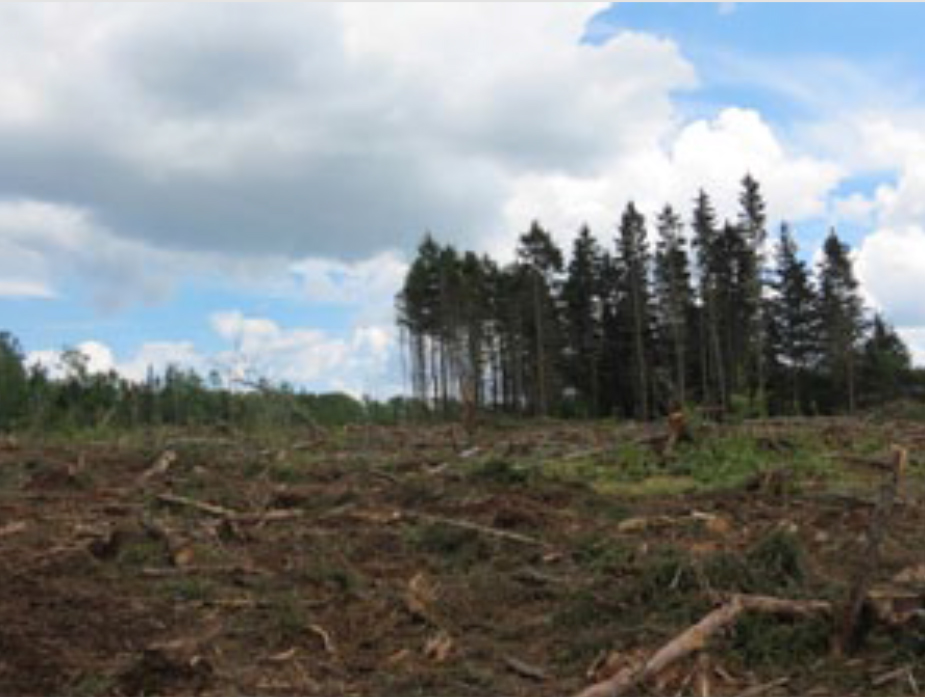 |
Ian thought about the north end of his property where his father and grandfather had spent most winters, cutting logs for beams and walls. He didn’t have the time or the equipment to revisit that stand, which had remained untouched for the last 30 years. He was interested in the results that selection management had to offer.
Perhaps he would go and have a word with the contractor about his availability next winter.
Module 2 - Lesson Three Quiz
| Questions: | 17 |
| Attempts allowed: | Unlimited |
| Available: | Always |
| Pass rate: | 75 % |
| Backwards navigation: | Allowed |
Lesson Four - Putting It All Together
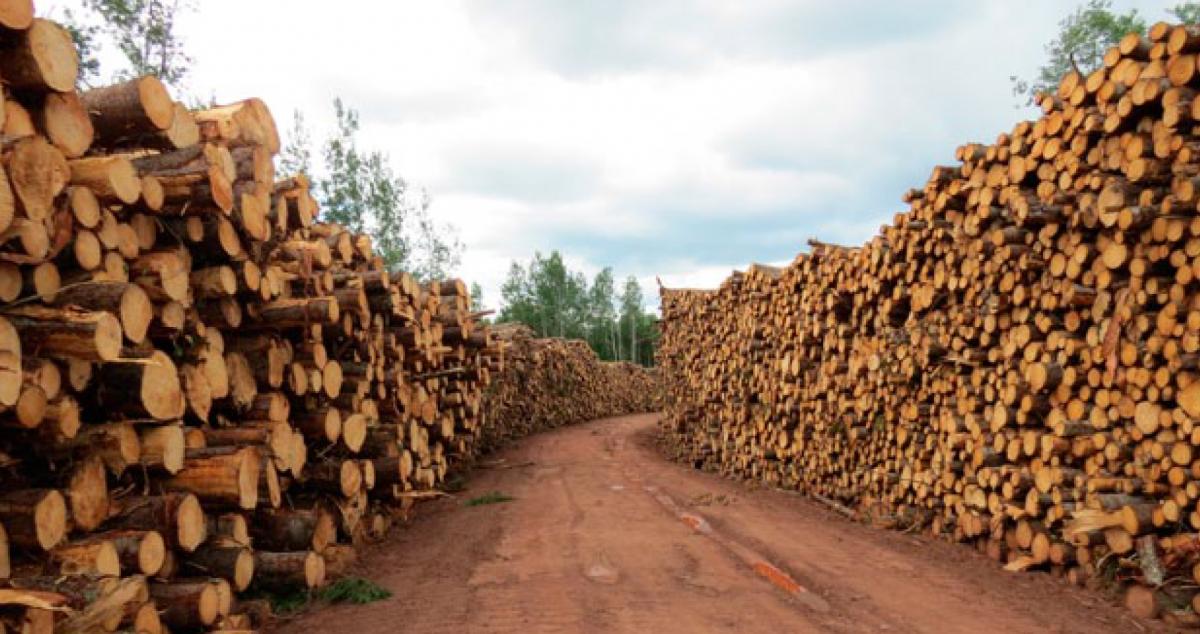 |
| Piles of cut-to-length wood ready for trucking. |
Harvesting is a silvicultural tool. It can be used to establish new regeneration or to release already- established seedlings and saplings. It can be used to create space for mature trees and to favour some species over others. Harvesting can be used to increase the quality of your woodland.
The choice of harvest prescriptions and harvesting systems requires careful consideration. Before you make a decision about harvesting a stand, you should use pre-treatment assessments to gather as many details as possible about the stand. How is the stand likely to regenerate? What is the soil texture and depth? Are the soils likely to be damaged during certain times of the year? What are the stand’s physical attributes (height, diameter, species and health)?
Harvesting Systems
In this module, four kinds of harvesting systems are discussed. The systems primarily differ from each other in the way the trees are harvested, the length to which they are cut, and how they are delivered to the side of the road. The systems are:
- Cut-to-length
- Random length
- Tree length
- Full tree and whole tree system
We will look at these harvesting systems individually.
Cut-to-length system
The name of this harvesting system indicates that wood is cut to pre-determined lengths. Mills require specific lengths for their products, and a good knowledge of each mill’s specifications is required. Trees are usually felled, de-limbed and cut to length at the stump. The wood is then picked up by extraction equipment, usually a forwarder, and transported to roadside.
Much of the cut-to-length wood that is harvested in Nova Scotia for pulpwood, studwood and firewood is between 2.44-meters (8-feet) and 2.75-meters (9-feet) in length. Softwood sawlogs are often cut into 3.66-m (12-ft), 4.27-m (14-ft) and 4.88-m (16-ft) lengths.
Cut-to-length wood is often easier to transport because all of the wood on a truckload is the same length.
Random-length system
In this harvesting system the trees are felled, de-limbed and cut once or twice to facilitate transportation of the wood, which varies in length. The wood is usually at least 3 meters in length, and can be extracted by skidder or forwarder. Once piled on a truck, the wood can be clearly seen to be of different lengths.
The wood is usually processed once it gets to the mill. Sawlogs and pulpwood are sorted from the pile and the remainder may be chipped for pulp or energy biomass.
Tree-length system
Wood that is felled, topped and de-limbed is called tree length wood. This wood is commonly 10-meters (30-feet) or more in length. It is usually dragged to roadside by skidder and trucked by semi-trailers.Like random-length wood, tree-length wood is cut-to-length at the mill, depending on product specifications. It can be sorted into several products such as sawlogs, pulpwood and energy biomass.
Full-tree and Whole-tree systems
Trees that are simply felled and transported to roadside are considered harvested with the full-tree system. Whole-tree harvesting includes also bringing the stumps to roadside, which is rarely – if ever – practiced in Nova Scotia forest management. The limbs are left on the trees until they are removed at roadside by a mechanical de-limber. The limbs, together with fine branches, needles and leaves, may be re-distributed over the harvested site to return nutrients to the soil, or they may be chipped or mulched into energy biomass and trucked. The main stem of the tree is chipped on-site or trucked to the mill for further processing.
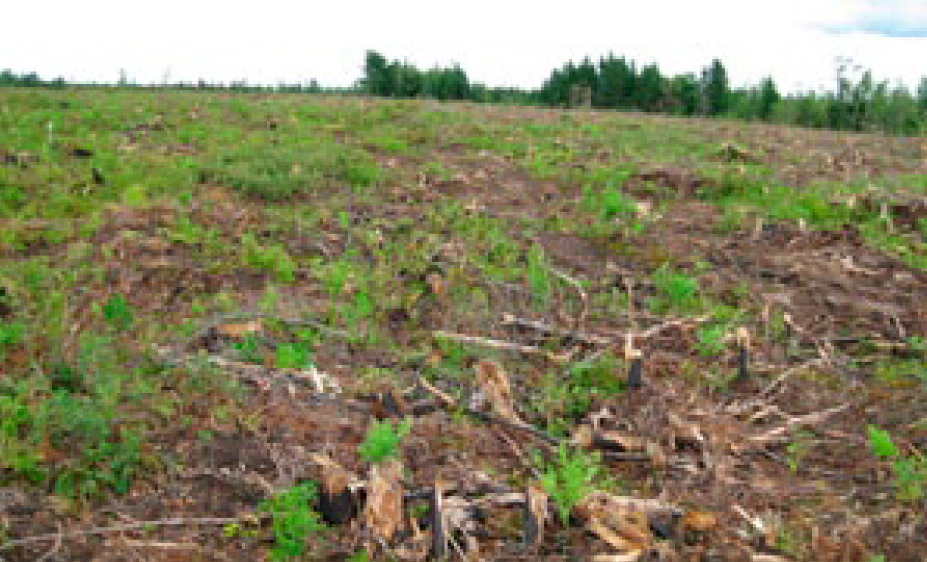 |
| A full-tree harvested site - Photo courtesy of NSDNR |
Detractors of the full-tree harvesting system indicate that the removal of the branches, twigs, needs and leaves and other material from the forest site depletes the soil of nutrients that are essential to healthy forest soils. This may be especially true on sites that may be no more than moderately productive. Full-tree and whole-tree harvesting systems are currently banned in Nova Scotia.
If you are harvesting your own wood, be sure to check with the mill to ensure that you are using the harvesting system that will allow you to maximize your revenue.
Harvesting Methods
Clearcutting
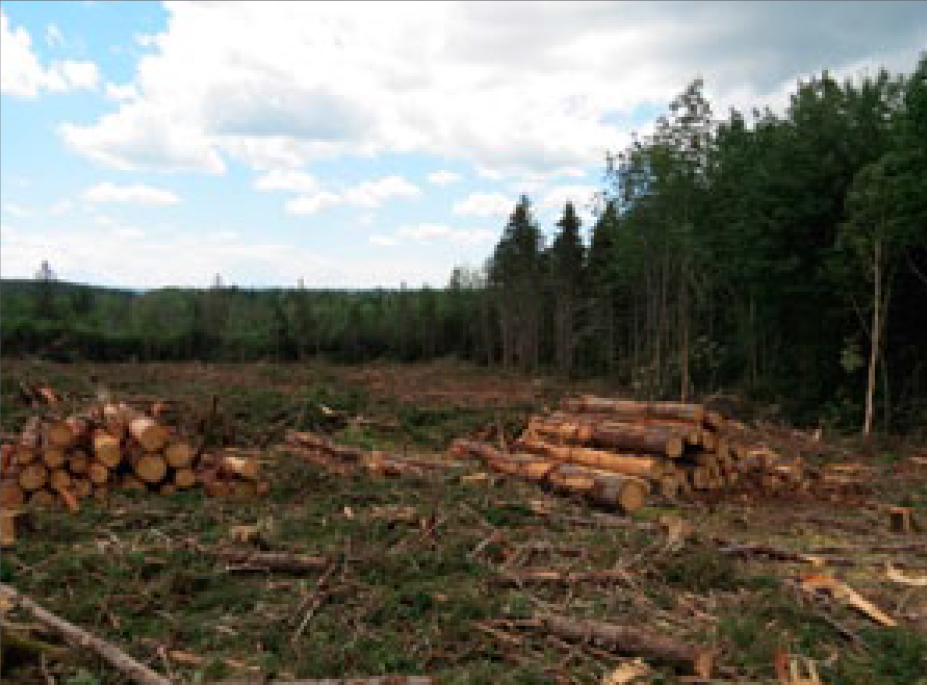 |
| A clearcut site |
Clearcutting is a stand-replacing harvesting practice that promotes and maintains an even-aged forest.
Most people are familiar with clearcutting as being the removal of most of the trees from a forest site. However, there are degrees to which trees can be removed, and in 2012 the Province of Nova Scotia defined a clearcut as: “…a forest harvest where less than 60 percent of the area is sufficiently occupied by trees taller than 1.3 meters.”
Stands that may be candidates for clearcutting include:
- Stands of old field white spruce that are mature and poorly rooted or have a high risk of blowdown.
- Stands of mature and overmature balsam fir in which there is adequate advanced regeneration.
- Stands that have been significantly damaged by insects, disease, fire or wind.
- Stands for which the landowner objectives include maximizing revenue.
When a site is clearcut, it regenerates to an even- aged stand. There may already be advanced regeneration present when the stand is cut, and the harvesting activity releases the regeneration into full sunlight. This is often a shock to the seedlings, particularly during warm sunny weather, and allowances should be made for losing a portion of the regeneration to this “burn-off” effect.
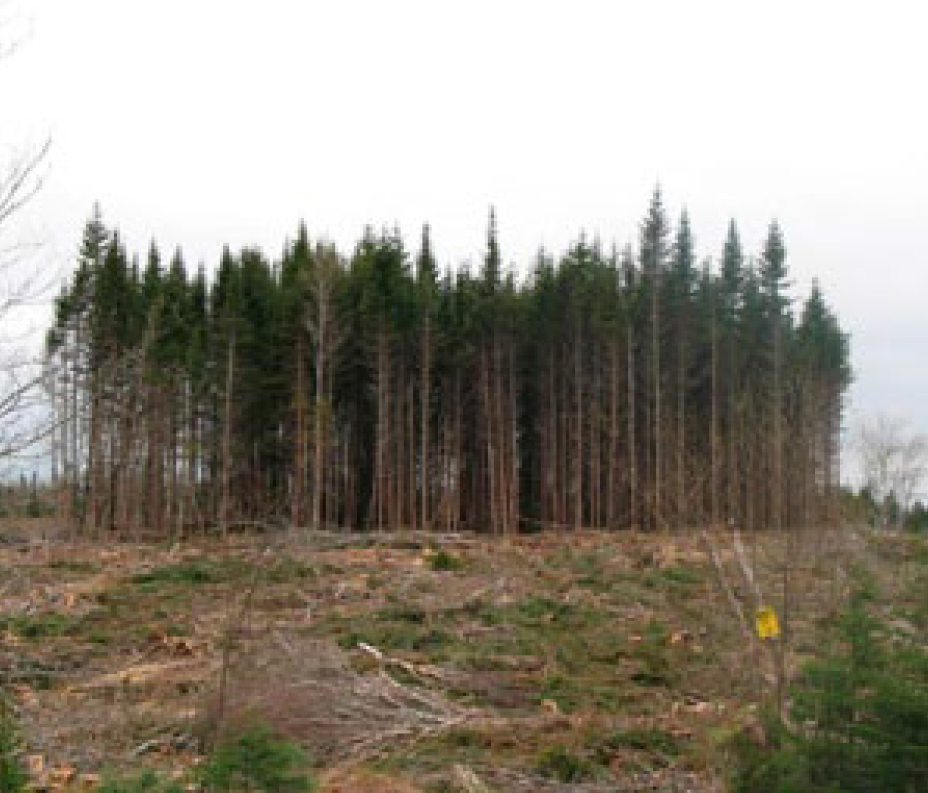 |
| Legacy/wildlife clumps must be left in larger clearcuts |
Selection Harvesting
During the past ten years there has been an increase in uneven-aged management on private woodlands in Nova Scotia through selection harvesting. The concept of uneven-aged management is not a new one: some woodlands have been maintained in an uneven-aged condition for generations. To many people it is regarded as an alternative to clearcutting, but it very much depends on the species- and age-structure of the forest in which you are working. Uneven-aged management can be carried out at either the stand- or woodland- level.
 |
|
Harvesting processor working in a selection harvest |
Some woodland owners prefer to retain a continuous forest canopy to protect the soil and regeneration from the drying effects of wind and sunlight, and from erosion during heavy rain. There may also be better opportunities to conserve habitat for some species of wildlife. Many woodland owners appreciate the visual appearance of selection harvesting since this harvesting method does not usually create large openings. Selection management also has the added advantage of maintaining a larger proportion of growing stock in higher-value trees, and it is not necessary to maintain as many young trees as in even-aged management. Good trees of higher value can be maintained as long as the owner wishes, since they do not need to be harvested all at once as with an even-aged system.
Uneven-aged management can be challenging for woodland owners who are used to even-aged management. It requires adequate planning and a good knowledge of the tree species, age structure and ground conditions of your woodland. And it is a flexible, dynamic, intensive method of managing your woodland, if the conditions are suitable.
It is important to get to know the ages of the trees on your woodland, particularly if you are considering selection management. Trees that seem different in height and diameter may be nearly the same age. This may be especially true if a woodland has been high-graded in the past, when only the largest and best trees were removed.
An uneven-aged stand contains at least three age classes of trees. Each age class is separated from others by 15 to 20 years, depending on tree species. A stand containing 80 year-old red spruce and hemlock, 50 year-old balsam fir and a mix of regeneration that is at least 30 cm in height, is an example of an uneven-aged stand.
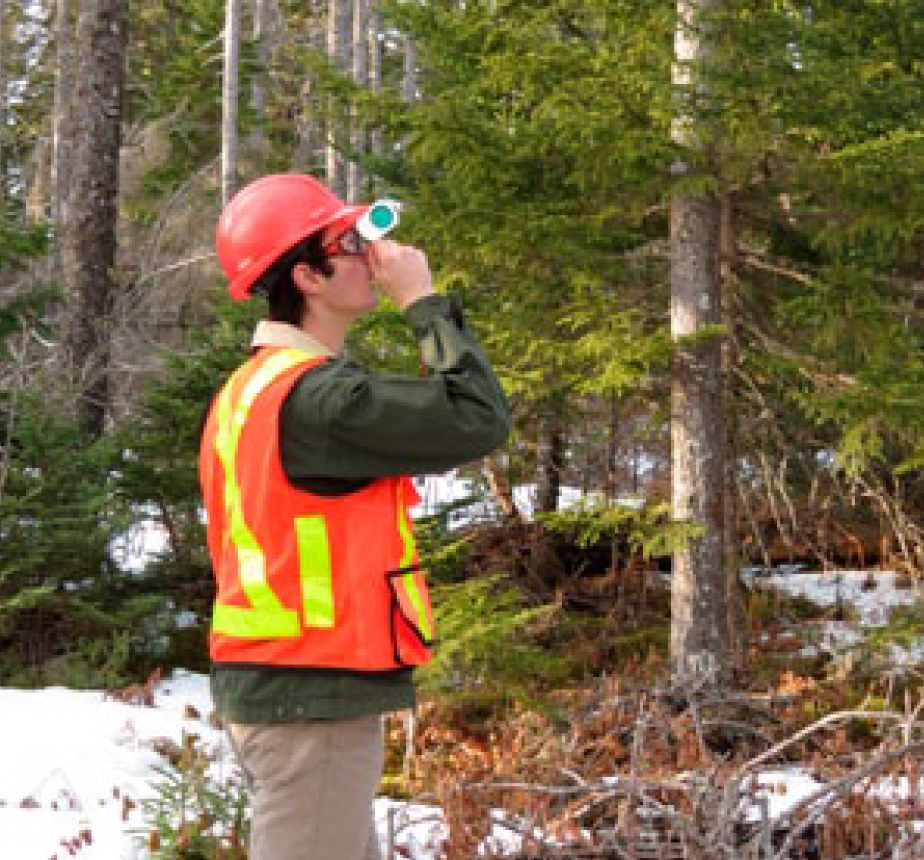 |
|
Checking tree heights in a selection harvest |
The best way to determine the approximate age of a tree is through the use of an increment borer, as discussed in Module 1 of this home-study series. Using the borer, a core sample can be taken from a tree and the growth rings counted. It should be noted that obtaining a core sample from hardwood trees can be difficult, and the ring count is not always reliable.
There are two types of selection harvesting: single- tree selection and group selection. The ways in which they maintain an uneven-aged forest condition are different, but the objective of both methods is the same: to maintain a permanent, but irregular cover over a forest area.
Single-tree selection
When individual trees are harvested throughout a stand or woodland, it is called single-tree selection. Done properly, this can be one of the most expensive types of harvest because of the high costs of wood extraction. If harvesting is to be done mechanically, trails will need to be cut to allow access by the processor and forwarder. These trails often regenerate aggressively after harvesting.
It is important to plan your selection harvesting carefully, particularly with the single-tree method. In some cases, trees are marked by forest professionals prior to cutting, which increases the chances of a successful treatment. During single- tree selection harvesting it is often tempting to cut only the largest and best quality trees for market. This poorly-informed process is called high- grading, and can leave woodlands in degraded condition. It is also termed selective harvesting.
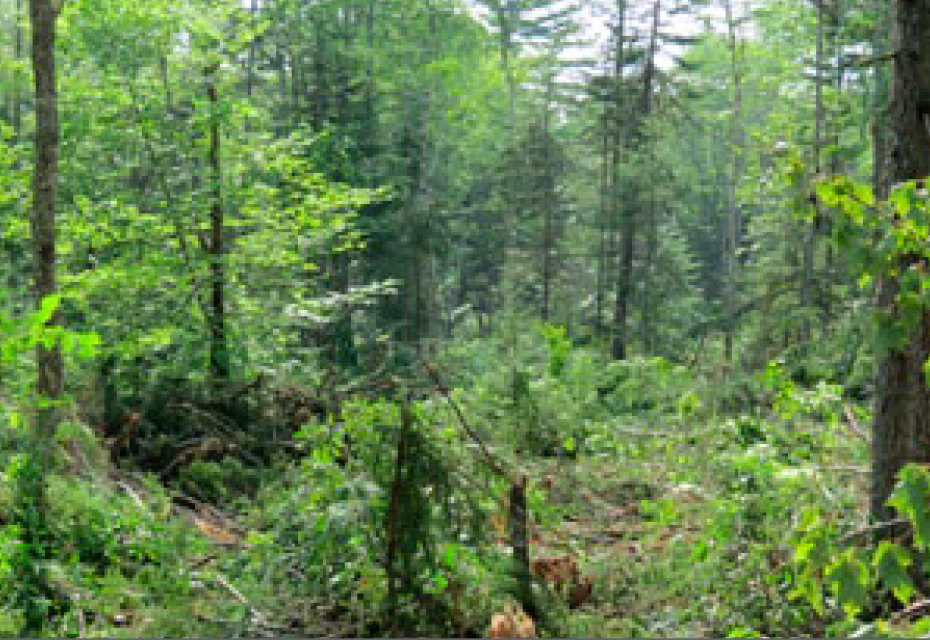 |
| Recently completed single-tree selection harvest |
Ideally, a proportion of trees of all sizes and ages are harvested during selection management, in order to maintain balanced age classes. If you are uncertain about how to proceed with a single-tree selection harvest, you should request assistance from a forest professional.
Many woodland owners carry out selection management on their own, using a chainsaw for felling and a farm tractor or skidder for extracting the wood. Horses and oxen can also be used. Skillful trail layout is important for efficient wood extraction.
Group Selection
A less expensive and popular uneven-aged management method is called group selection harvesting. Instead of harvesting trees throughout a stand or woodland, groups or clumps of trees are harvested, with extraction trails joining them. Once a group of trees has been harvested, the area is left to regenerate naturally. In some cases, fill planting may be necessary if regeneration is not satisfactory. Group selection is particularly successful in managing for high-quality hardwoods.
 |
| Completed group selection in hardwood |
The group selection method is an excellent way of ensuring that a woodland is never over-harvested. With careful planning and proper timing, small patches of trees can harvested at regular intervals. If your objective is to harvest trees at age 60 every five years, and if adequate regeneration is ensured, you could harvest one-twelfth of your forest area every five years under the group selection system. And because the harvesting work is concentrated in designated areas (preferably marked in advance), felling and extraction costs are reduced.
The frequency, size and shape of harvested patches can vary. If you are interested in promoting the regeneration and growth of mostly shade-tolerant tree species, patches should be no more than 30 meters in diameter. Such small openings allow partial shading over much of the harvested patch. Openings greater than 0.3-ha allows both shade-tolerant and shade-intolerant species to regenerate, and follow-up treatments such as manual weeding or pre-commercial thinning may be necessary to control unwanted vegetation.
Group selection mimics small-scale gap disturbances, with the resulting effect being the efficient establishment of natural regeneration within the harvested areas. As this type of harvesting is carried out over decades, newly regenerated areas will maintain the uneven-aged condition of the stand or woodland. As with single-tree selection harvesting, it is important to harvest all ages, sizes and quality of trees. Harvesting only the best trees will result in high-grading, or selective, harvesting.
Other Types of Harvesting Methods
Where wind-throw risk is minimal, partial harvests such as selection and shelterwood harvests can provide seed and shelter for shade-tolerant species. Seed-tree harvests, in which trees are left as seed “banks”, can be used to promote regeneration of Acadian Forest species.
Both small-gap and large-gap disturbances are common in the Acadian Forest. From individual trees that die and break off, or are windthrown, to entire forest stands, the Acadian Forest is full of irregularities and disturbances.
As a woodland owner, you can emulate these disturbances with partial harvesting.
Uniform Shelterwood Harvesting
Common on private woodlands 20 to 30 years ago, shelterwood harvesting is resurging as woodland owners see the benefits of establishing natural regeneration of long-lived, shade-tolerant species.
 |
| A successful softwood with good regeneration |
Shelterwood harvesting works best when carried out in stands of mature trees that have good genetic qualities and are capable of producing good seed crops. If no natural regeneration is present in the stand, a thinning of the overstory by removing the poorest-quality and least-desirable trees will allow sunlight to reach the forest floor. The sunlight will also reach the upper crowns of the seed trees, stimulating flower and seed production.
Once the seeds are germinated on the forest floor, the resulting seedlings will be protected from drying winds and full sunlight by the overstory trees. The partial shade will also discourage pioneer species such as aspen, gray birch and pin cherry from becoming established.
When the area s fully stocked with healthy regeneration the entire overstory - or some of it – can be removed. Care must be taken during felling and wood extraction to avoid damaging the regeneration and any residual trees. Both forwarders and skidders can be used effectively to extract wood from shelterwood harvests. On some woodlands, horses or oxen are used to bring harvested wood to roadside.
The primary risk in shelterwood harvesting – as it is in most forms of partial harvesting – is windthrow. Shelterwood harvesting should only be done on sheltered sites with well-drained, deep soils in which the trees are firmly rooted. For this reason, a pre-treatment assessment should be done on the site prior to prescribing this treatment.
For the most part, shelterwood harvesting results in even-aged stands which can be further managed to promote an uneven-aged structure should the landowner wish.
Seed-tree Harvesting
When it is anticipated that there will be little desirable regeneration following a clearcut harvest, leaving good seed trees scattered throughout the harvested site may be an option.
Choosing windfirm, seed-producing trees is critical to the success of this harvesting method. Ensure that the soils are deep and well-drained, and that the site is sheltered from prevailing winds.
It is important to keep in mind that there will not be enough coverage of seed trees to provide shade to discourage aggressive pioneer species, so expect plenty of shade-intolerant trees.
In most operations, the seed trees are left to form part of the new stand, and possess some legacy value. Good choices for seed trees are white pine, red spruce and red oak, although red spruce is most likely to break off or blow down soonest.
Some landowners recognize that most seed trees are likely to blow down, and are willing to sacrifice these trees to establish good natural regeneration.
It is important to properly plan a seed-tree harvest prior to clearcutting the site. Marking the seed trees in advance will ensure the retention of the best specimens.
Looking at the Landscape
Your woodland does not sit in isolation on the surrounding landscape. There may be several properties adjacent to yours, and each will have both similar and different characteristics in comparison to your woodland.
It can be challenging to think of large landscapes and where your woodland’s place is within it. A good way of seeing a bird’s-eye-view of your woodland in the landscape is to look at an aerial photo. You’ll see patterns repeated across the landscape. There may be dark patches of softwood stands, ridges of tolerant hardwoods, or boggy lowlands. You may see deeply cut valleys or river floodplains. Recognizing such patterns of ecosystems is central to ecological landscape classification.
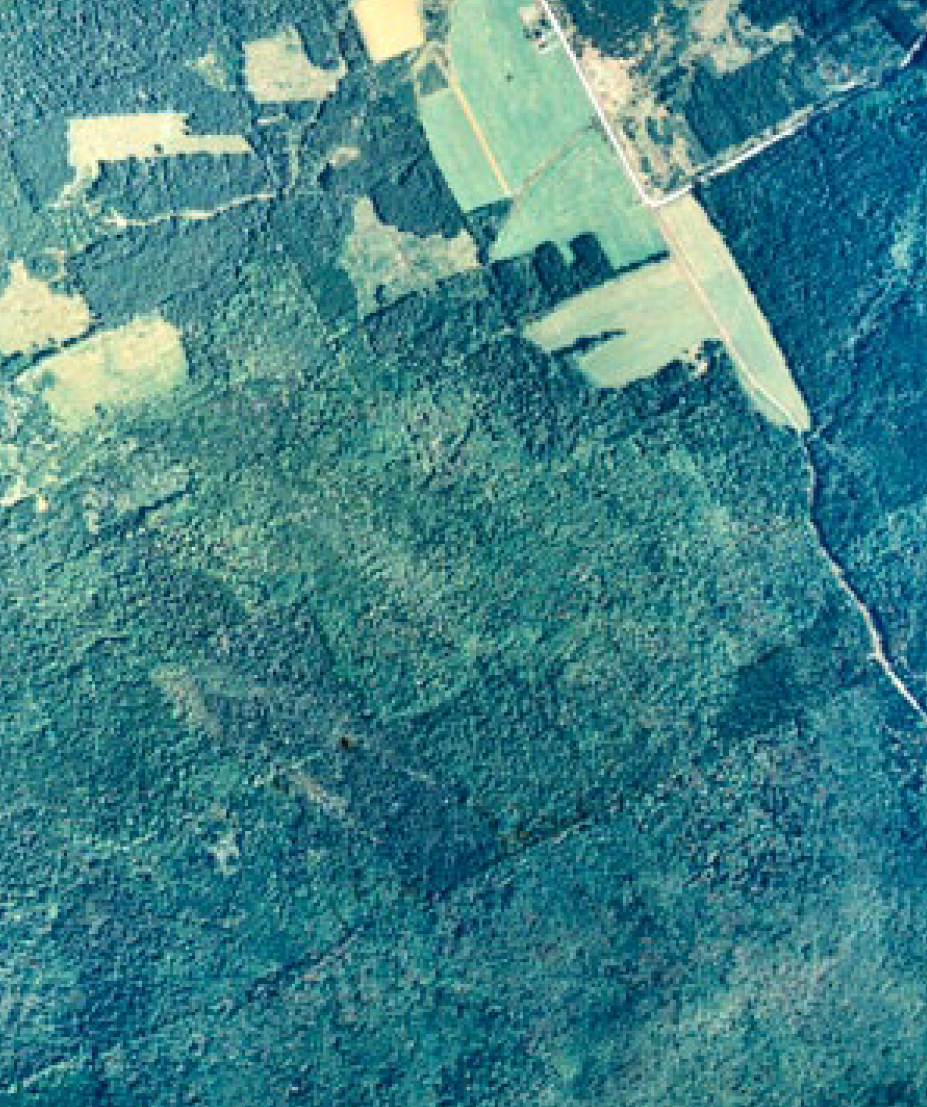 |
Vegetation types and soil types are similar on the landscape around your woodland. Natural disturbances such as spruce bark beetle or whitemarked tussock moth outbreaks are examples of landscape-level disturbances. The tussock moth may be infesting your trees, but it is likely infesting most of the woodland around you on a larger scale.
It is important to recognize that your woodland does not stand in isolation, and that activities on your property (such as harvesting) can affect the surrounding landscape.
Restoring Features of the Acadian Forest
The objectives of many woodland owners in Nova Scotia include the restoration of species and physical features of the Acadian Forest which were present in the province prior to land-clearing for European settlement.
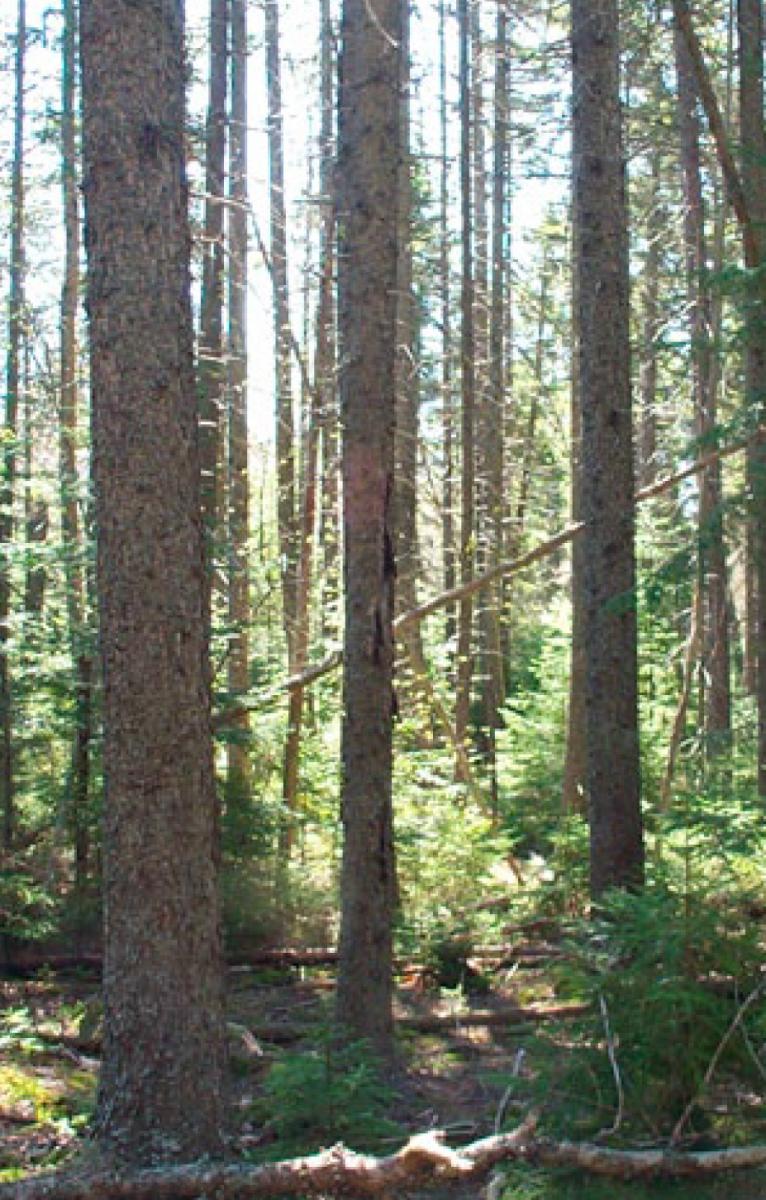 |
| A typical late-successional Acadian forest |
The Acadian Forest included a high proportion of mature to overmature trees of long-lived, intermediate and shade-tolerant species, including:
- Red spruce
- Black spruce
- Eastern hemlock
- White spruce
- White pine
- Balsam fir
- Sugar maple
- Yellow birch
- White ash
- Red oak
It is important to note that natural disturbances were present in the pre-European settlement period and there was also an abundance of fast-growing pioneer tree species that are associated with disturbance, including:
- Red maple
- Aspen
- White and gray birch
- Tamarack
- Pin cherry
In some stands, “restorative” harvests can be carried out which promote the regeneration and growth of Acadian Forest species. Selection harvests, shelterwood harvests and seed tree harvests can be used to increase the proportion of these species in a stand or woodland.
Some of these species may already be present in your woodland, even in areas that have been clearcut for several years. If you have an area that was clearcut 10-30 years ago, take a walk through the harvested site and look carefully. You may find some slower-growing Acadian Forest species just becoming established in the shade of the fast- growing pioneer species.
It should be noted that anticipated changes in climate lend some uncertainty to the future vegetation of what is now the Acadian Forest. In less than a century, other tree species may be better suited to the climatic conditions of some areas of Nova Scotia, while some species which are presently found in the province may be less abundant.
 |
| Patterns on the landscape Photo Courtesy NSDNR |
Case Study 2
Tom and Susan Fields had to make a decision soon. With one son entering college and a daughter not far behind, family expenses were about to rise dramatically.
The Fields’ woodland was finally beginning to show the results of good management. Tom and Susan had worked hard to make sure that the family woodland was in better shape than when they had purchased it 22 years ago. At that time it had been a 20-hectare (50-acre) clearcut which had been harvested 15 years previously. It had regenerated naturally to an even-aged stand of sugar maple, red maple, balsam fir and yellow birch. Scattered through the area were also a few hundred hemlock seedlings. Tom had spaced some of the densest thickets ten years ago, to give the trees more space and light. He noticed that, soon after, many of the small openings had seedlings present.
Now, at 37 years old, the hardwood trees were over 15-meters (45-feet) tall. It was easy to imagine that someday there would be a very large volume of good-quality wood growing on the woodland. Most of the best trees were sugar maple and yellow birch. Both Tom and Susan enjoyed visiting the woodland and were pleased with the growth of the trees.
One Saturday morning there was a knock at the Fields’ front door. The visitor was a logging contractor who made it clear that he would like to harvest the Fields woodland as soon as possible since, he indicated, the market for pulpwood was quite good. A lump-sum payment up front would make it easy for everyone, the contractor indicated.
 |
The offer seemed substantial. The contractor had offered to replant the site after harvesting. But the Fields had a nagging doubt.
The previous year the Fields had attended a field day on the property of the winner of the regional woodland owner of the year award. They remembered the horse-drawn hay ride through the woodland and the owner’s remarks that “sugar maple is my best and most valuable tree species because it makes wonderful sawlogs and will practically grow in the dark.” Tom and Susan marveled at the height and diameter of some of the trees, and asked the owner why he hadn’t yet cut them. “Those trees are like money in the bank,” the owner explained. “They gather interest as they accumulate wood volume, and also start new accounts by distributing good seed crops every few years. And,” he stated, “I know that those will be good seedlings because they came from my best trees.”
To Tom and Susan, it seemed like a common-sense approach, and they had not forgotten the reasoned, no-hurry demeanor of the woodland owner as he had explained that he cut some trees every year, both to make money and to make room for new trees.
Tom and Susan knew that they had a growing bank account on their woodland. They weren’t, however, sure that they wanted to cash it in right away. Besides, selling all their trees for pulpwood or firewood seemed to undermine their long-term objectives of maximizing their income from the woodland.
They quickly decided to turn down the offer to immediately harvest the woodland. Not surprisingly, the contractor offered an additional 10 percent, indicating that markets had since improved. This time, the Fields were blunt. “We’re looking for more long-term management,” stated Tom. “Well, don’t be surprised if the bugs eat your trees soon,” shot back the contractor as he left.
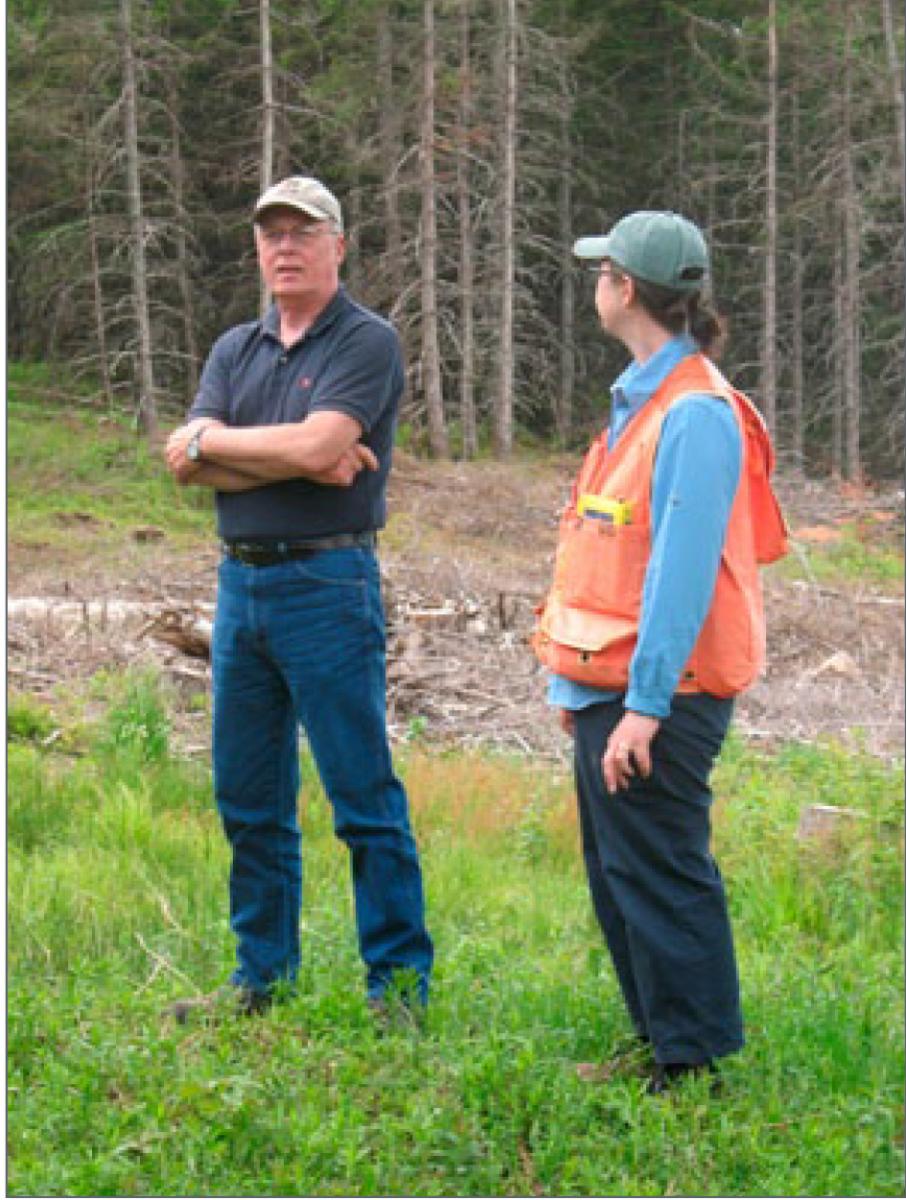 |
Within a few weeks of the contractor’s visit, another contractor visited the Fields, inquiring about purchasing their standing wood. Markets, he said, were good for pulpwood, but he did not want to cut all the trees. Instead, he would do another thinning, which would create small openings for new seedlings to become established. He would focus on removing the balsam fir and the poorest quality hardwood. He indicated that he had access to silviculture funding which would allow him to carry out good quality work without unduly impacting the value of the wood to the landowners.
The Fields felt that this sounded like a better idea than clearcutting their woodland, but were still undecided about what should be done next. A few days later they contacted a local forest professional, who recommended that a stewardship plan be the first step in their decision-making process. Tom and Susan agreed that this seemed like a logical way to proceed.
The landowners’ objectives were very important, stated the forester when she met with them to discuss their goals for the woodland a few days later. “We should be able to make this work,” Valerie stated as she showed them aerial photos of the woodland and surrounding countryside. From the photos the Fields could already see some differences in the patterns and colors within their woodland, and were surprised to see the variability that existed across their woodland. From the ground it looked much the same. From the air it was easy to spot clumps of hardwood and darker patches of fir.
They could even see a poorly-drained area near the center of the woodland, where the trees were shorter and yellow-green in color. “You’ll likely want to stay away from that wet site with heavy equipment,” said Valerie. She pointed to areas that she felt were worthy of special attention. “When I put your plan together, everything will be checked on the ground,” she said.
Within a couple of months, Valerie had the Fields’ stewardship plan completed. After examining the growth rings on the trees, she had concluded that it would be worthwhile to wait another five years before any of the trees were harvested. “They really haven’t begun to slow down yet because of overcrowding,” she said. “But as soon as they do, that’s the best time to thin.”
Valerie had also sampled the soil throughout the woodland and classified the forest ecosites. The results reinforced the validity of thinning on two areas, which covered over half of the woodland area. The soils were quite well-drained over most of the woodland, and had good structure for solid tree rooting.
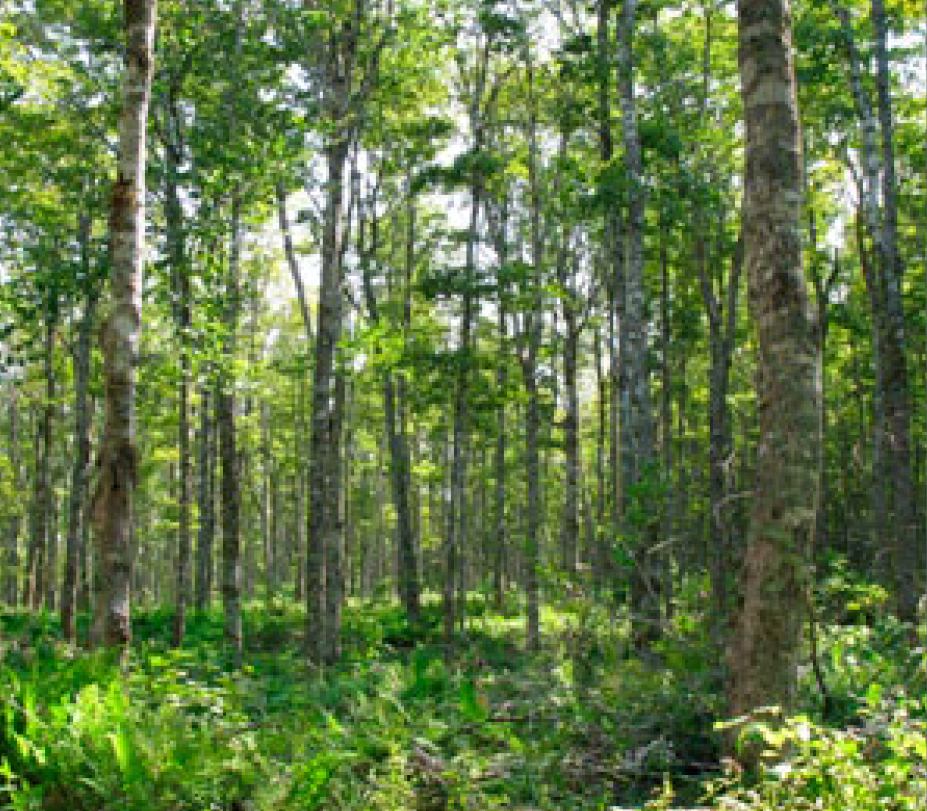 |
The Fields looked forward to thinning the woodland in a few years. It seemed like a progressive activity that would generate some income. Their anticipation was hard to contain.
Five years later, the Fields contacted Valerie, asking whether she would once again look at the trees on their property. From several outings on their woodland, Tom and Susan knew that the trees had grown at least another three meters (10-feet) in height. Valerie seemed impressed with the growth of the trees and indicated that – if treated just right – these even-aged stands could perhaps be converted to uneven-aged stands. She explained that if the Fields were interested in smaller – but more frequent – income, uneven-aged management might suit their objectives.
Securing funding for the thinning was not an issue. A provincial government agency provided silviculture assistance for small private woodlands and could help offset the cost of thinning. A local contractor specialized in commercial thinning and was hired to do the job. His small-scale harvester and forwarder were perfect for felling trees and extracting the wood without damaging the remaining trees. The contractor removed about one-third of the trees on the two sites that were thinned. With one of the Fields’ daughters entering university, the stumpage payment for the thinning had been timely indeed.
The Fields were a little concerned that the thinned areas of their woodland would suffer the same fate as the “beauty strips” they had noticed along the sides of the highway next to clearcuts. They hoped that within a few years the trees were not flattened by wind.
Over the next 20 years their fears faded. The presence of two hurricanes had made them anxious, but Valerie’s previous site work had confirmed that the two stands of thinned trees should be windfirm.
The Fields noticed something else. Where the thinning had been completed, there was an abundance of younger trees growing in the openings. The sizes of these trees ranged from tiny seedlings to wiry poles over five meters in height, and there was a mixture of softwood and hardwood regeneration: balsam fir mingled with sugar maple and white ash. Valerie had been right – these two stands, treated appropriately, now had an uneven-aged structure.
There were now trees of all sizes and ages throughout Tom and Susan’s woodland. In the thinned areas, the age difference was remarkable. Fifty-year-old sugar maple trees sheltered young ash seedlings, and patches of balsam fir carpeted the larger openings. Sugar maple saplings were scattered among the taller trees. The Fields were pleased to see this mixture of hardwood and softwood species among the regeneration.
The Fields had noticed something else. As the trees had aged on their woodland, so they too were aging. Now close to retirement, it was time to consider more harvesting to help supplement their savings. Valerie had moved west to find employment, so they contacted their local woodland association for help. Before long Peter, a forest technician, had visited their woodland, updated their stewardship plan and had made some recommendations for harvesting, which the Fields were ready to hear.
“Selection management is a harvesting method which can promote natural regeneration, increase growth on your best crop trees, and harvest the trees that are ready for market,” explained Peter. Trees are cut throughout your woodland, always ensuring that good growing stock is left. This can be done by harvesting patches, or by harvesting individual trees.” The Fields liked this idea, and although they were tempted to harvest individual trees for the visual appeal, Peter explained that cutting patches, or group selection, was cheaper and would likely yield a better return. “And it maintains the uneven-aged structure of the woodland,” he added.
Peter contacted a harvesting contractor, who arrived at the Fields’ woodland about a month later. The harvesting equipment, floated in by a low-bed tractor-trailer, was smaller than most of the other harvesters and forwarders that Tom and Susan had seen working nearby. Although both machines had rubber wheels, these were covered by tracks. The contractor was able to use most of the roads and trails that were built during the thinning. Although these had many young trees growing in them, Peter assured the Fields that this was not a concern, and that there were plenty of other small trees growing throughout the woodland.
 |
Tom and Susan were amazed at the piles of wood that were soon growing by the side of the road. With for different products, the contractor was carefully sorting the wood for its highest value. The very best logs would be sawn for timber-frame homes, which had resurged as an in-vogue dwelling design. The other wood was sold for traditional building lumber and decorative wood fencing. The Fields were impressed with the contractor’s ingenuity in sourcing local markets, keeping transportation costs down.
When the contractor left and the last piece of wood was trucked away, the Fields walked through their woodland. They saw where the contractor had cut trails to access small patches of wood, leaving everything else intact. Susan gasped as a doe and two fawns walked slowly and deliberately through one of the harvested patches, stopping briefly to gaze at the woodland owners. A pileated woodpecker started hammering on a nearby tree, looking for insects.
 |
As they walked they were pleased with the small amount of soil disturbance and the feeling that were still very much surrounded by their woodland. Nearly one-third of the wood volume on their woodland had been harvested, but it felt like much less. There were still trees of all sizes, from seedlings to mature trees. There were still excellent trees remaining for seed production. Tom and Susan were sure that the harvested patches would be thickets of trees within a decade.
What perhaps pleased them most was the fact that they were going to be passing this woodland to the next generation, and it was a fine example of good forest management. They had cared for it over the decades, asking questions of professionals when they weren’t sure of the answers, and making sure that planning was an important prerequisite. Above all, Tom and Susan were pleased that they had been patient. They learned that the real benefits of woodland stewardship grew slowly, but were worth the wait.
CONCLUSION
It is apparent to you by now that any decision to harvest your woodland should not be taken lightly. This module has offered advice on how to proceed with your decision-making, and has underlined the vital importance of proper planning. Ideally, you should have a woodland stewardship plan – the basics of which is outlined in Module 1A – that will have far-reaching and important continuity throughout the management of your woodland.
Your goals will reflect where you may wish to harvest on your woodland, and how much should be harvested. This module reviewed the many values that woodland owners have, and many of these values may be more important than income from wood products. You have also seen how harvesting can provide a source of income to those landowners who plan for this objective.
If you plan to harvest, be observant. See what the site can tell you. The use of Forest Ecosystem
Classification can go a long way in helping you reach a decision. This module has indicated that you should carefully assess the species, age, health, presence of regeneration and windfirmness of a stand prior to making any harvest decision. You should also determine if the soil conditions will withstand heavy equipment, if it is to be used.
Pay attention to detail, but don’t become bogged down in it. Sometimes the larger view is a better one, particularly if you can see your woodland, and yourself, on the landscape. Above all, don’t limit your choice of harvest method to those you’ve reviewed in this module. Often, combinations of systems work well. Let your woodland tell you what is best.
Talk with other woodland owners who have experience with harvesting: they are your best source of information. Go to woodland field days. See what others are doing, and you’ll see what works. Seek out the advice of a forest professional, and above all, have fun! Owning woodland is an exciting adventure!
Module 2 - Lesson Four Quiz
| Questions: | 13 |
| Attempts allowed: | Unlimited |
| Available: | Always |
| Pass rate: | 75 % |
| Backwards navigation: | Allowed |
Shelterwood harvesting encourages establishment of shade-tolerant species like red spruce and eastern hemlock.
Shelterwood harvesting encourages establishment of shade-tolerant species like red spruce and eastern hemlock.
The Acadian Forest is typically composed of fast-growing pioneer species like trembling aspen and gray birch.
The Acadian Forest is typically composed of fast-growing pioneer species like trembling aspen and gray birch.
Appendix A
Completing a Pre-treatment Assessment
Pre-treatment assessments are done at regular intervals – called plots – over the area of a forest stand. Usually a minimum of five plots should be done in order to have a high degree of confidence that the data is representative of the whole stand.If the stand is less than five hectares, a minimum of five plots should still be done. In stands more than five hectares in size, one plot per hectare is usually done. For example, in a 10-hectare stand, a minimum of 10 plots should be done in order to ensure that the whole stand area is sampled. Sometimes, more plots may be required to accurately assess the site, particularly if the vegetation or soil types change frequently over the site.
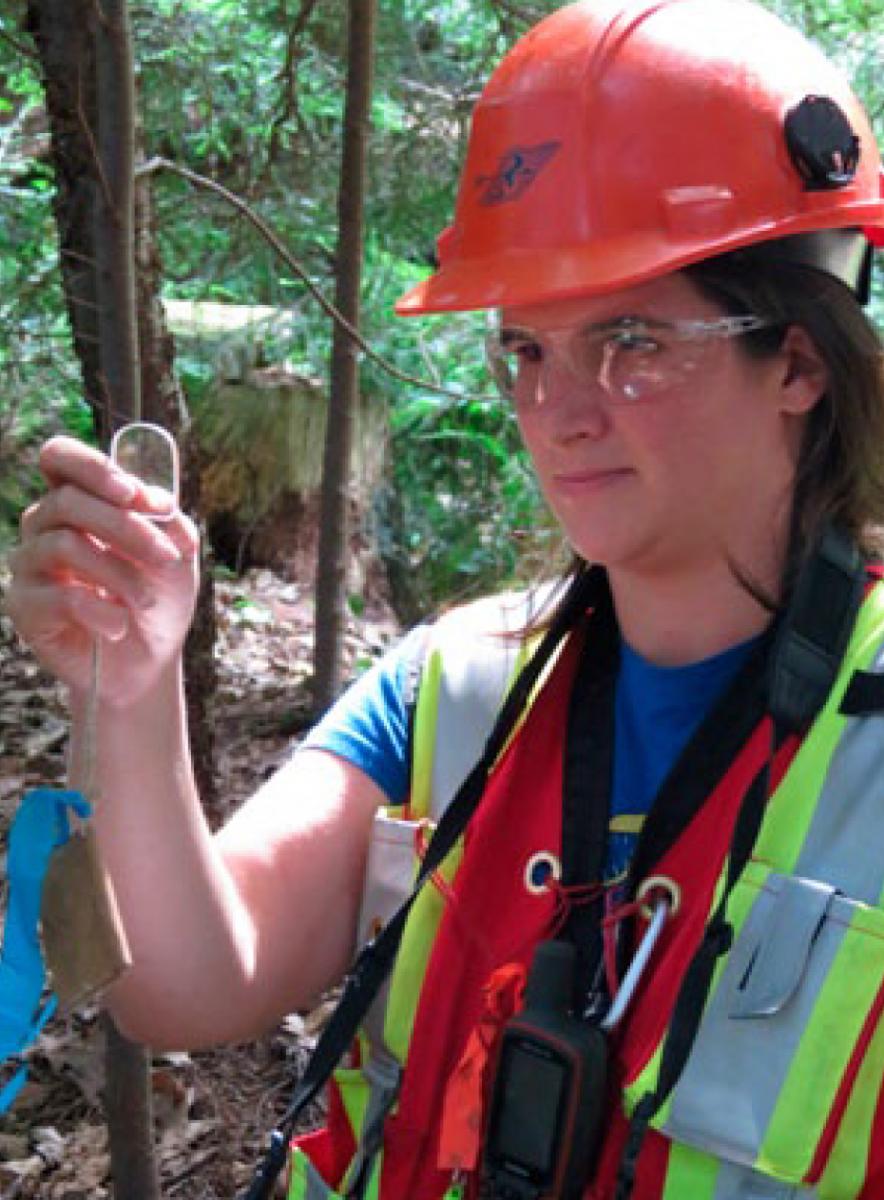 |
| Using a wedge prism |
Once the number of plots has been determined, each plot should be sited at regular intervals over the stand area. This could be at 50- or 100-meter intervals, depending on the size of the stand. At the center of each plot, basal area is determined using a wedge prism, and each tree that is tallied is measured or estimated for diameter in five-centimeter increments. Each tallied tree is assessed for quality, and whether that quality will increase or decrease over the next 15 years.
Basal area is a measure of the distribution and diameter of trees on a forest site, and can be used in calculating standing wood volume. It is measured in m2/ha.
In the case of shade-tolerant, long-lived Acadian forest species - such as red spruce, eastern hemlock, sugar maple and yellow birch - the quality and value of the trees usually do not decrease over 15 years unless they have been damaged. If the trees are healthy, of good form and without obvious physical defects that would lower their value or longevity, they are called Acceptable Growing Stock (AGS).
Some trees, even long-lived ones, often exhibit defects such as scarring or rot, or they may be relatively short-lived species such as trembling aspen and tamarack. There could also be genetic factors that result in forked or crooked stems. The trees are termed Unacceptable Growing Stock (UGS).
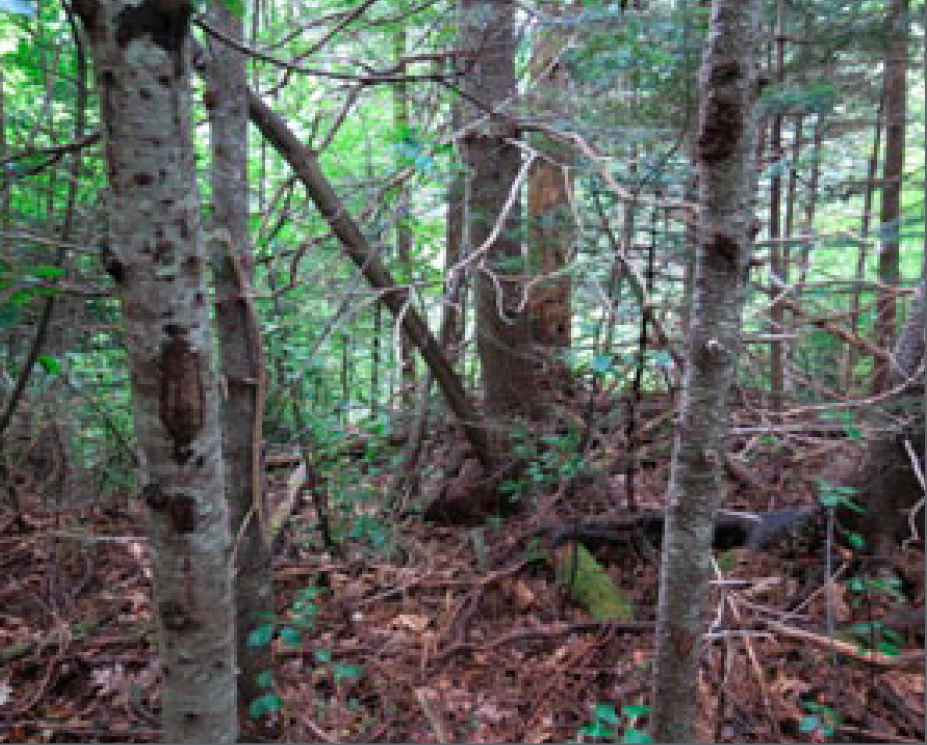 |
| An example of unacceptable growing stock |
In a stand that has been high-graded for decades, perhaps even for generations, one would not expect to find many good-quality trees. On the other hand, trees that are present in a stand that has been managed by selection harvesting are often of better quality, and will usually increase in value in the future if properly tended.
Each tree that is tallied is classed as either AGS or UGS. If there are not enough AGS in the stand, partial cutting may not be warranted. If, however, the landowner’s objectives include restoring Acadian forest tree species and stand characteristics, some partial cutting that will promote these objectives could be undertaken.
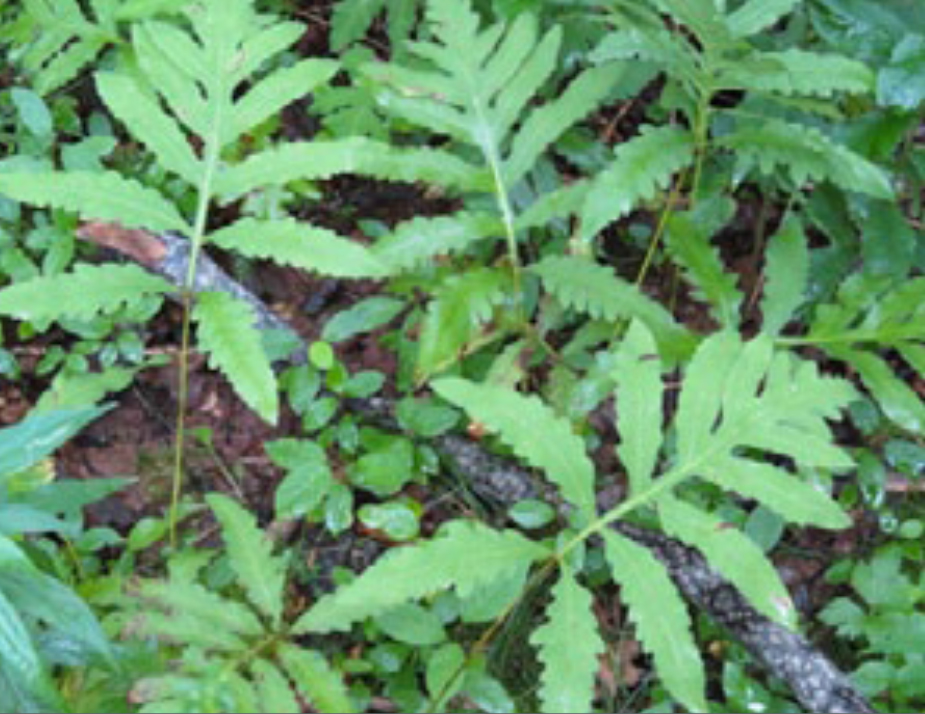 |
|
Ground vegetation – in this case sensitive fern – which is often found on poorly drained sites |
The pre-treatment assessment is not yet complete. The ground vegetation and soil type should be sampled in order to gain a complete picture of the forest ecosystem. The ground vegetation is identified and one or more soil samples are taken with a soil auger. The ground vegetation is typed against descriptions found in the NSDNR publication “Vegetation Types in Nova Scotia”. The soil is sampled for texture, moisture retention and other features such as stoniness and depth. It is identified by using the NSDNR publication “Forest Soil Types in Nova Scotia”.
 |
|
Using a soil auger to assess soil type |
Together, the vegetation type and soil type at each plot will allow the identification of ecosite type, which can be used in helping to provide a harvest prescription for the stand. The ecosite type can be determined with the help of the NSDNR publication “Forest Ecosite Types of Nova Scotia.”
While pre-treatment assessments sound complex, most forest professionals who are familiar with them are able to complete four to six points per hour. It is time well spent when one considers that harvest decision-making is often difficult.
References
Braun, E.L. 2001. Deciduous Forests of Eastern North America. Caldwell, NJ: The Blackburn Press. 596 p.
Davis, M.B. 1996. Eastern Old-Growth Forests. Washington, DC: Island Press. 383 p.
Freedman, B. 1989. Environmental Ecology. Toronto: Academic Press. 424 p.
Harrison, G. 2006. Nature’s Way. Gagetown, NB: Earthwood Editions. 188 p
Lindenmayer, D.B and J.F. Franklin. 2002. Conserving Forest Biodiversity. Washington, DC: Island Press. 351 p.
Maine Forest Service. 2009. Forest Trees of Maine, Centennial Edition. Department of Conservation, Maine Forest Service. 176 p.
Robinson, G. 1988. The Forest and the Trees: A Guide to Excellent Forestry. Washington, DC: Island Press. 257 p.
Smith, D. 1962. The Practice of Silviculture. New York: John Wiley and Sons. 578 p.
Simpson, J. 2008. Restoring the Acadian Forest. Tantallon, NS: Four East Publications. 154 p.
Walker, L.C. 1990. Forests: A Naturalist’s Guide to Trees and Forest Ecology. New York: John Wiley and Sons. 288 p.
Additional Resources:
NS Department of Natural Resources Novascotia.ca/natr
Forest Professionals
Registered Professional Foresters Association of Nova Scotia www.rpfans.ca
Nova Scotia Forest Technicians Association www.nsfta.ca
Woodlot owner organizations
Federation of Nova Scotia Woodland Owners www.fnswo.ca
Nova Scotia Woodlot Owners and Forest Fiber Producers Association www.nslffpa.org
Nova Scotia Woodlot Owners and Operators Association www.nswooa.ca
Harvesting and silviculture contractors
Forest Service Directory www.fsdb.ca
Silviculture assistance
Association for Sustainable Forestry www.asforestry.com
Woodlot road assistance
Forest Products Association of Nova Scotia www.fpans.ca
